The little-known story of how St. Thomas the Apostle brought Christianity to India
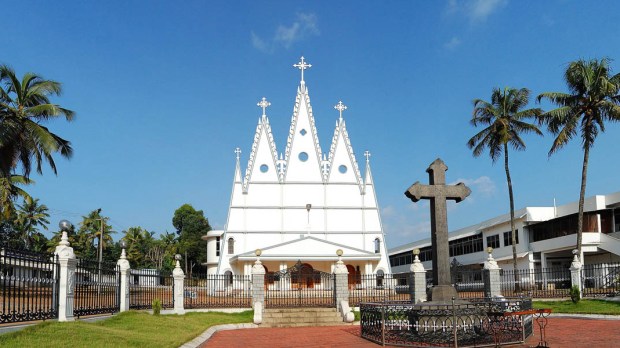
Challiyan | CC BY SA 3.0
Pentecost delivered the gift of tongues soon after Jesus had proclaimed: “… go and make disciples of all nations.” The paradox is how little recognition goes to the evangelist who used his powers of communication to take the message further than anyone else.
Eight days after Jesus met his disciples following the Resurrection, he encountered St. Thomas. Since then, St. Thomas the Apostle has been better known as Doubting Thomas. His least-used title is “Apostle of India.” In the Subcontinent, the situation is very different. There, even the vast non-Christian majority of 1.7 billion are mostly aware of his role as missionary extraordinaire.
When Vasco da Gama’s fleet reached India in 1498, the Portuguese were surprised to find Christian communities thriving in the south of the Subcontinent. They were even more surprised by the locals’ certainty that their church had been established by St. Thomas. They shouldn’t have been, as countless travellers, including Marco Polo, had claimed that the saint’s grave was there. St. Thomas had preached to the Hindus and the Jews of southern India and had won thousands of converts. For the St. Thomas Christians, there is still no doubt that theirs is an unbroken tradition going back to their patron’s arrival in 52.
Click “Launch a slideshow” in the image below:
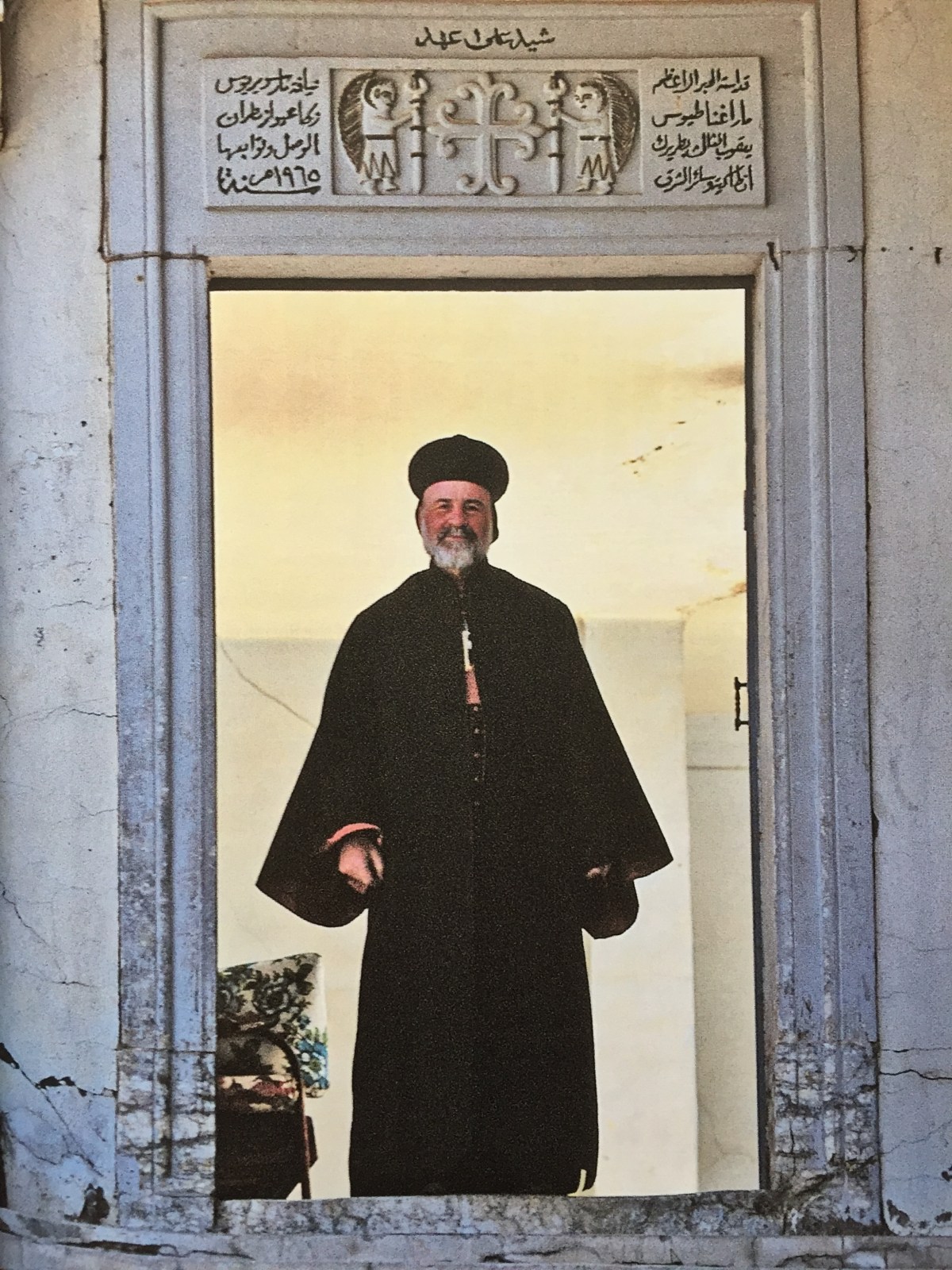
There has been a revival of interest in St. Thomas’s path through the Middle East, with the continuing plight of Christians in Syria and Iraq. Further east than that, however, the co-religionist radar is picking up almost nothing. A recent book by one of the most enterprising travelers of present times might help western Christians look again at the development of their faith.
Serena Fass is an 80-year-old writer, photographer and wanderer who has followed St. Thomas’s progress across much of Asia. Her book In the Footsteps of St. Thomas corroborates the evidence that has existed for centuries. This does not come from the Bible or other texts that historians find unreliable, although written sources described his travels as long ago as 1,800 years. On-site investigation is the new key to unlocking the truth about St. Thomas.
There are few Christian communities that go back to the time of Jesus’s disciples. Serena Fass finds much to support the beliefs that the faithful in India hold firm to, although there are still plenty who dispute them. In those pioneering days, India was the magnet that drew Europe to the East. When Columbus chanced upon what was later called the West Indies, it was India he thought he had reached. India was the trading world’s most profitable destination.
The evidence of Thomas’s presence in India is considerable. Some of it stretches the imagination while the rest is at least as plausible as the Turin Shroud, albeit with less publicity. Keeping a low profile has been the secret of survival. Levels of hostility to Christians in India are on the rise, and the belief that St. Thomas was martyred by either a local ruler or a Brahmin priest hardly lessens what is considered by some Hindus to be a blood libel.
St. Thomas’s tomb is less conspicuous than that of other Apostles to be honored with a basilica. His original south Indian resting place was not in a Christian stronghold, and he was buried without much ceremony. Most of his bones were removed from India in the 3rd century and sent to Edessa in Mesopotamia, where the saint’s vital role in India was acknowledged at the time. Once again the bones’ progress is followed across the globe by Serena Fass as they eventually end up in the Italian town of Ortona.
The Catholic Church maintains a neutral stance on the proposition that Christianity might have been established in India long before it was in most of Europe. There is more evidence of St. Thomas’s life in India than anywhere else; in 1956 Pope Pius XII granted minor basilica status to San Thome Cathedral in Madras.
Serena Fass has collated traditions handed down over almost 2,000 years, along with a physical trail that includes some very old Crosses. The “Thomas Christians” of India use a Cross of distinctive shape. Crucifixes are rare, as would be expected of a community that started long before the Corpus became an accepted part of Christian imagery.
Relics of St. Thomas are less common than his tombs, of which there are purportedly six. A fascinating reliquary exists in Mylapore. Originally housing some of the saint’s bones, it is now empty. The decoration tells a heartening story of coexistence in India. With decoration in Hindu style, probably by Muslim craftsmen, on a Christian theme, it is a testament to Indian multiculturalism. The only thing missing is a Jewish element; it is known that the earliest converts to Christianity in southern India were, like Thomas himself, Jews. This is part of the Diaspora that tends to be as forgotten by the Jewish community as St. Thomas of India is by Christians around the world.
Even if every other part of the St. Thomas story is one day proved to be false, there can be no doubting the Thomas Christians’ incontrovertible inks with Syrian Christianity. In southern India they still use the liturgical Syriac language — a dialect of the Aramaic language spoken by Jesus and St. Thomas. Syria was the bedrock of early Christianity and an important part of the Roman empire, trading with southern India from the Red Sea. This was inevitable for the Romans, with their addiction to pepper and knowledge of monsoon winds. Roman coins and other evidence is found in abundance. In the 1930s one of Britain’s greatest archaeologists, Sir Mortimer Wheeler, even found the remains of a Roman trading post.
At a time when the earliest Christian communities are being eradicated in the Middle East, their legacy at least lives on in India, thanks to St. Thomas.
‘In the Footsteps of St Thomas’ is available through Aid to the Church in Need UK , a Catholic charity dedicated to helping the persecuted and oppressed, and through Amazon in the US.
Articles like these are sponsored free for every Catholic through the support of generous readers just like you.
Help us continue to bring the Gospel to people everywhere through uplifting Catholic news, stories, spirituality, and more.


EARLY CHURCH HISTORY
Apostle “doubting thomas” and india.

“On the evening of that first day of the week (the Sunday of His Resurrection), when the disciples were together, with the doors locked for fear of the Jewish leaders, Jesus came and stood among them and said, “Peace be with you!” After he said this, he showed them his hands and side. The disciples were overjoyed when they saw the Lord.
Again Jesus said, “Peace be with you! As the Father has sent me, I am sending you.” And with that he breathed on them and said, “Receive the Holy Spirit. If you forgive anyone’s sins, their sins are forgiven; if you do not forgive them, they are not forgiven.”
Now Thomas (also known as Didymus), one of the Twelve, was not with the disciples when Jesus came. So the other disciples told him, “We have seen the Lord!”
But he said to them, “Unless I see the nail marks in his hands and put my finger where the nails were, and put my hand into his side, I will not believe.”
A week later his disciples were in the house again, and Thomas was with them. Though the doors were locked, Jesus came and stood among them and said, “Peace be with you!”
Then he said to Thomas, “Put your finger here; see my hands. Reach out your hand and put it into my side. Stop doubting and believe.”

Thomas said to him, “My Lord and my God!”
Then Jesus told him, “Because you have seen me, you have believed; blessed are those who have not seen and yet have believed.” John 20:19-29
The above is the passage in John’s Gospel where Thomas received his name, “Doubting Thomas.” “A skeptic, like Thomas, is a person who doesn’t believe something is true unless they see evidence—coming from the Greek word skeptikos, which means “thoughtful or inquiring.”
There is a lot of clear evidence from Christians in India that Thomas went all the way to India from Palestine and brought many to the Lord even though they had not seen the Resurrected Jesus: “blessed are those who have not seen and yet have believed.”
How did Thomas born in the early 1st century AD and died in 72 AD get to India? He could have taken the normal Silk Road overland to the East as most traders did. But that route did not go into India. It scratched the tippy top of India.
This writer believes: Thomas took the sea route in a trading ship beginning in Rome and ending at Barigaza in northern India or Muziris in southern India. Perhaps he traveled with a Jewish man named Abbanes about whom nothing is known. However, there were in Thomas’ arrival and still are today Jewish communities in India some of whom assert their ancestors went to India in the days of King Solomon in the 900’s BC. To this writer that is an astonishing fact!

Thomas the Missionary was killed by uncertain people on July 3, 72 AD. Some say he was “speared through” by Hindus. Others posit he was killed by natives who hated him for bringing Christianity to India. Others just say “Thomas was killed at St. Thomas Mount in Chennai on 3 July in AD 72, he was castrated, and his body was interred in Mylapore.” Ephrem the Syrian (Died 373) states that the Apostle was killed in India, and that his relics were taken then to Edessa. This is the earliest known record of his death. That is about all one can know for sure.

Thomas, the Doubting One, took the life and resurrection of Jesus of Nazareth almost 3,000 miles from Jerusalem to the people in India. He ministered for 29 years in that land. So many missionaries think their work is futile and will not last after they leave. Use Thomas’ example. He went to India. He did not know the language but God helped him learn it. He was apparently a good builder and God helped him build at least 7 churches for the people who responded to the GOSPEL. He rattled with his message some people who eventually murdered him. BUT you must know that your ministry as a missionary will not be “forgotten, will not have been for naught.”
Take heart.
Thomases’ Jesus Christ is now the 2nd most popular person in India and daily the faith in Him is growing. As of 2020, the population of India was 1.38 Billion. Following were the number and percentages (of total population) of the four major religions as of 2011:
Muslims 138,188,240 (13.4%)
Christians 27,080,016 (2.3%)
Sikhs 19,215,730 ( 1.9%)
Buddhists 7,955,207 (0.8%)
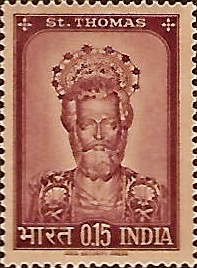
CLICK FOR HOME PAGE

What historical proof is there that St Thomas did come to India? Any documentation or indications that he really did come to Kerala?
The long-accepted belief is that St. Thomas preached in South India and established churches and left congregations known to this day as the St.Thomas’ Christians, and that in the end he was martyred in St. Thomas’ Mount and buried in San Thome, now a suburb of Madras. Thus the glory of the introduction of Christianity in India, by time-honoured tradition, has been ascribed to St. Thomas the Apostle. There are many scholars who hold the view that he did and there are also those who take the opposite stance. I will be trying to present as briefly as possible the evidence that points to the conclusion that St. Thomas’s visit to the shores of South India is not unfounded.
St. Thomas in India
The Doctrine of the Apostles, which was probably written in the second century AD, mentions that St. Thomas evangelised India. We also have St. Ephraem (A.D. 330 – 378) attesting that the Apostle was martyred in India and that later his relics were taken to Edessa (a city in Upper Mesopotamia, present day Şanlıurfa inTurkey). Origen (A.D. 184 – 253) and Eusebius of Caesarea (the bishop of Caesarea Maritima from A.D. 315 to about A.D. 340) state that St. Thomas evangelised the Parthians and the same statement is made by the “Clementine Recognitions,” the original of which may have been written about A.D. 210.
A much more detailed description of his journey is given in an apocryphal literature called Acta Thomae (The Acts of St. Thomas) for which there also exists certain historical data that would suggest that the apocryphal source contains some truth in them. Harnack, a prominent church historian, has assigned to it a date before A.D. 220. This work connects with St.Thomas two Eastern Kings, whose names appear in the Syriac version as Gudnaphar/Gundaphar, and Mazdai. It is said in it that Thomas was able to convert the King Gudnaphar, his brother and many other people. After that, while St.Thomas was preaching “throughout all India,” he went to the city of King Mazdai. There, as the result of his converting Mazdai’s wife Tertia and a noble lady named Mygdonia, he was condemned to death. He was slain with spears by four soldiers on a mountain outside the city. And he was buried in the sepulchre in which the ancient kings were buried. But subsequently, while King Mazdai was still living, the bones of the Apostle were secretly removed by one of the brethren and were taken away to “the West”.
Corroboration from external sources has been found in the form of coins which from 1834 onwards have been obtained from Beghram in the vicinity of Kabul, from Pathankot in Gurdaspur district of Punjab on the north-east of Amritsar, from Kandahar, and from various places in Sindh and Seistan, bearing the name of one of the Kings, Gondopheres, mentioned in the tradition. The discovery of what is known as the Takht-i-Bahi inscription (in 1857) has helped to date the reign of Guduphara/Gondophernes in A.D. 20 or 21, and in establishing the fact that in A.D. 46 his dominions included, in India itself, at any rate the territory round about Peshawar.
It is about the second king, Mazdai, that scholars are divided regarding where he reigned – was he the King Vasudeva of Mathura or a king from the southern part of India. The attempt to identify King Vasudeva with Mazdai does pose some historical problems. One of them being, in The Oxford History of India, 1919, it is stated that Vasudeva came to power in A.D. 182. If this is true, then it would place him too late in the timeline to be the second King that the Apostle visited.
St. Thomas in South India
The Acts of St. Thomas and the Doctrine of the Apostles does mention that the Apostle preached “throughout all India” and established himself there, by making himself Guide and Ruler of the church (Bishop) which he built there and ministered there. Therefore excluding Southern India from the scope of St. Thomas’s labours and confining him to the north does not seem reasonable. Instead we do find some descriptions that points towards the possibility of a South-Indian apostolate of St. Thomas. In the Acts the General who heard of St. Thomas preaching comes to him in a cart drawn by cattle, which is characteristic of Southern India. Had this incident taken place in the north, the General would have come mounted on a steed. Gondophares, for instance, is figured on his coins riding a horse, not seated in a cart drawn by oxen. Also seen is the depiction of Mygdonia using the palanquin when going to see the Apostle, which is also specially peculiar to Southern India. Even the name for the mode of transport originates from the Tamil word pallanku – a covered type of litter for a stretched-out passenger, carried on long curved poles carried on the shoulders of four or more bearers.
Even in the hymns of St. Ephraem (A.D. 300 – 378) we see the traditional belief that St. Thomas was connected to India. Though the exact name of the place of his martyrdom and burial is not mentioned, it does have some indicators as to where these events might have taken place. In the hymns the place whom St. Thomas evangelised is called “land of people dark” and the people themselves are called “the sunburnt ”. Both of which point to the possibility that the tradition current in St. Ephraem’s time was that St. Thomas preached mainly in Southern India and was martyred and buried there.
We also have St. Gregory, Bishop of Tours in his “Liber in gloria martyrum” (Book of the Glories of the Martyrs) a work which he revised in A.D. 590, shortly before his death, recording the testimony of one Theodore who visited the tomb of the Apostle in Mylapore. He records the presence of a large church covering the tomb and a monastery nearby and also that the remains of the Apostle which had remained buried there for a time were later transferred to Edessa.
In the Anglo-Saxon Chronicle we find King Alfred sending an embassy to the tomb in India, in fulfilment of a vow made at the time he was besieged by the Danes. Again in the 13th century we find Marco Polo and Friar John of Monte Corvino visiting the tomb in India. Though the name of the small town is not mentioned, there is no reason to doubt that it was Mylapore, which alone, has always claimed to be the place where St. Thomas was first buried. There are several other records of the presence of the tomb, one of which was made by certain Nestorian bishops, who wrote in A.D. 1504, to the Catholicus of the East, speak of “the houses of St. Thomas in a city by the sea named Meliapur”.
St. Thomas in Kerala
The traditional belief among the St. Thomas christians of Kerala is that St. Thomas landed on the Malabar coast in Kodungallur and that he established seven churches. It is also believed that the Apostle then travelled to the Coromandel Coast and suffered martyrdom there. This same belief was found among the Christians of Socotra by St. Francis Xavier – that St. Thomas landed on the Malabar Coast. To have traditions from several places separated by such long distances to converge, does show that these are indeed not unreasonable beliefs.
Even before the birth of Christ, there are records of trade happening between the Greco-Roman world and present day Kerala. Muziris, roughly identified as present day Kodungallur, was an ancient harbour at the Malabar coast which was key to trade between South India and Persia, the Middle East, North Africa, and the (Greek and Roman) Mediterranean region. From the location of unearthed coins and artifacts it can also be concluded that there was an inland trade route between this port and the east coast of India. In short, St. Thomas not only could have known about this distant land but also had the means to reach here by making use of the already existing trade routes. The traditional account that Jews had started coming to Cranganore (Kodungallur) for trade from 562 B.C. also makes a trip by the Apostle very much plausible.
In the book The Catholic Church in India by Paul Pallath, the author talks about various folksongs and ballads that speak of “the mission, death and burial of the Apostle ”. Though these were only written down much later after their original composition, it is certain that these existed from a very early time period. The author goes on to list Margamkalipattu (song-dance of the Way), Rambanpattu (Song of the Ramban), Thomaparvam (Ballad of Thomas) and Veeradiansongs (recited by a particular Hindu caste) – all of which talk about the apostolate of St. Thomas.
As for the earliest records that we have regarding Christianity in India comes from Eusebius, a Christian historian, who notes that St. Pantaenus had visited India somewhere between A.D. 177 and A.D. 192 and found Christian communities already present in India and that these communities where using a version of the Gospel of Matthew in Hebrew letters. Though Pantaenus attributes the presence of the Gospel to the Apostle Bartholomew, there are scholars who believe that the difficulty in understanding the language might have caused him to misinterpret the reference to Mar Thoma as Bar Tolmai (the Hebrew name of Bartholomew).
After taking into account all the evidence that is there, it can be said with certainty that there is nothing impossible or improbable about St. Thomas travelling to India, specifically the southern part of the country. When combined with the fact that solemn Ecclesiastical confirmation has been given, regarding the apostolic origin of St. Thomas Christians, by several popes and that there is neither a rival claim regarding the tomb of the Apostle nor archeological evidence against it, to hold the view that St. Thomas had come to Kerala, would be completely reasonable.

Edin Michael
Disclaimer! The views, thoughts, opinions presented here belong solely to the author and are not necessarily the official view of the Jesus youth movement.
3 responses to “What historical proof is there that St Thomas did come to India? Any documentation or indications that he really did come to Kerala?”
That was a good article, but there are so many more sources which can corroborate the details. This one feels too concise – as if it’s lacking sources.
There is always room to improve an article. Kindly share the information with us. We will verify it and include in the article. God bless.
Thanks for the article. Please help with the references of the source as a bibliography for further study.
Leave a Reply Cancel reply
Your email address will not be published. Required fields are marked *
Save my name, email, and website in this browser for the next time I comment.
Suscribe to get answers on your email
Smithsonian Journeys Travel Quarterly: India
A Smithsonian magazine special report
Smithsonian Journeys Travel Quarterly
The Surprisingly Early History of Christianity in India
Modern Syrian Christians of Kerala believe that the Apostle Thomas visited in A.D. 52 to baptize their ancestors
Paul Zacharia; Photographs by Lynn Johnson
:focal(1009x819:1010x820)/https://tf-cmsv2-smithsonianmag-media.s3.amazonaws.com/filer/9e/86/9e86f720-5ed7-4c6f-aa6d-a3c9e7cea18c/sqj_1601_india_kerala_05.jpg)
The first hat I ever saw was worn by Father Lawrence, an elderly priest who said Mass for the rubber-plantation workers in the Kerala village where I spent a Catholic childhood. When he came to our house for coffee, he lifted the curiously rounded hat and bowed with grave courtesy, a gesture I remember vividly because we did not know of such things then. Years later I would learn that it was a pith helmet.
We got to know Father Lawrence because attending his ramshackle chapel near our family farm was far easier than enduring the hilly, one-hour walk to our parish church. The traditional-minded in our parish frowned upon this because the plantation church followed the Latin rite, not the Syrian rite, although both are Catholic. As for us children, none of this mattered in the least. At the plantation church, we squatted on the mud floor brushed smooth with cow-dung paste and tormented ant lions in their tiny pits scratched into the earth. When we attended the parish church, we risked a caning to sneak into the downhill cemetery and peer into the “well,” in which unearthed bones and skulls from old graves had been unceremoniously dumped.
Of course we had no way of knowing then that the Latin rite had come to Kerala by way of the 16th-century Portuguese or that the Syriac rite had come far earlier, in the centuries just following Christ’s birth. Therein hangs a tale of the spices—pepper, cardamom, cinnamon—that made Kerala a hot spot in the ancient world, a story that helps explain how Christianity came to India not once but twice.
The state of Kerala is India’s Down Under, a narrow strip of land overlooking the southern tip of the subcontinent that is monsoon driven; sun drenched; humid; lush green; full of rivers, streams, lakes, backwaters, coconut trees; and teeming with people. The Arabian Sea’s white beaches fringe Kerala to the west, while the Western Ghats, with their impenetrable tropical forests and eternities of grasslands, define its eastern boundary. The distance from the sea east across the state’s midsection—a water world of backwaters merging into the rubber tree-filled farms—to the tea and cardamom plantations of the hills, averages only between 20 and 75 miles. Few areas in the world boast more ideal growing conditions for spices. Long before Jesus’ time Jews, Arabs and other ancient maritime traders settled in Kerala to buy, trade and store spices.
Modern Syrian Christians of Kerala (the majority Christian population here) believe that the Apostle Thomas—the one who so famously questioned Jesus—visited here in a.d. 52 and baptized their forefathers. Historians surmise that the diverse, rich trading center of Kerala may well have drawn this Palestinian Jew of the Roman Empire who wished to preach the Gospel. Thousands of churches today bear his name, their rituals and theology derived from Eastern Orthodox traditions in the liturgical language Syriac, a formation of Aramaic, the dialect Jesus—and Thomas—spoke. For decades now, the liturgical language of Kerala Christians has been Malayalam, the language of Kerala. Thomas’s name remains ubiquitous in Kerala, appearing on everything from baptism registers and the neon signs of jewelry stores and bakeries to the nameplates of dental surgeons and real estate developers’ ads. During the negotiations surrounding arranged marriages, it’s common for both families to make discreet inquiries as to whether the other’s ancestries reach back to the Apostle. A “yes” can prove a big plus—apart from the quantum of dowry, of course.
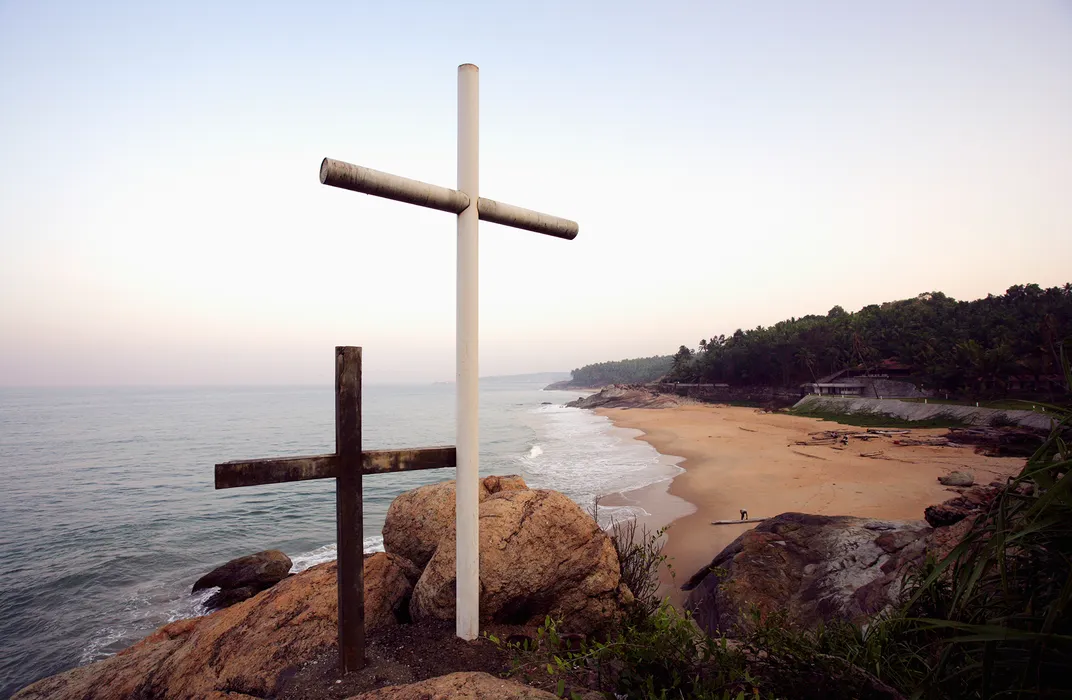
Then, in 1498, the famous Portuguese explorer Vasco da Gama sailed to Kerala to open up the first Europe-India sea route. Imagine his surprise when he found Christians. Two years later, Captain Pedro Álvares Cabral followed, bringing eight Franciscan priests, eight chaplains and a chaplain major. He left a few behind, who introduced the Latin—read Roman Catholic—rite. Once European Christianity had arrived, life was never the same again for Kerala Christians. The community would be split, re-split, changed, reformed and reinvented. But looking back, it seems clear that through the vicissitudes of history the community was moving ahead, not stumbling.
At Sabarimala, situated deep in the Western Ghats mountains of Kerala, sits the renowned forest temple of the Hindu god Ayyappa, a sacred pilgrimage site. Each night Ayyappa is sung to sleep with a sonorous and stately lullaby by the legendary Kerala singer Yesudas, a Christian whose name means “the servant of Jesus.” This is only one example of how Christianity has merged indistinguishably into Kerala’s—and India’s—rainbow of cultures. So, too, popular Hindu and Muslim artists created many Christian hymns beloved of church choirs.
The church spire is as much a part of the landscape as the temple tower and the mosque’s minaret. Although Christians constitute only 18.4 percent of Kerala’s 34 million population, they remain a prominent presence in all sectors of social, political and economic endeavor. The worldwide Kerala Christian diaspora is prosperous and strong. And the churches have been in the forefront of institution-building and in that sense a modernizing partner of Kerala society.
Up from Pala, a very Christian town with a famous temple right behind the bishop’s mansion, through Erattupetta, a very Muslim town with a celebrated church right in the middle of it, and at the end of a winding road into the hills of Western Ghats, with lovely vistas and many hairpin bends, a visitor reaches the Kurisumala Ashram (monastery), a place of serenity and beauty. The only sounds are cowbells jingling and the wind blowing over the grasslands. Occasionally a mist shrouds the meditation center. While the ashram doesn’t encourage visitors, it’s still worth a try. The Cistercian monk Francis Mahieu from Belgium and Bede Griffiths, a Benedictine from England, founded it in 1958 under the auspices of the Syro-Malankara Catholic Church. It is a rich destination for those seeking a contemporary blend of Hindu and Christian spiritualities.
The real showpieces of Kerala Christianity are its heritage churches, which express a fascinating mix of hoary history and contemporary faith. The 18th-century St. Thomas Cathedral at Pala, situated on the bank of the River Meenachil, about 40 miles southeast of Kochi, is a fine example of colonial church architecture, including a magnificent wood-carved altar in golden colors. However, both believers and church leadership seem to favor new flamboyant megastructures that exude power, and many of the heritage churches have been torn down. Some old ones, such as the exquisite twin churches of Ramapuram, which are 500 and 150 years old respectively, cling precariously to life. The local parish maintains that they are dangerously unsound and should be demolished, while a group of parishioners has received heritage status for the buildings and secured a court ruling that the churches are safe to use.
Kerala’s mainstream Christians unabashedly love the pomp and paraphernalia of ritual. A gathering of Kerala bishops dressed in the rainbow-hued grandeur of the Eastern Church, holding regal symbols of heavenly and earthly authority and seated on ornate thrones, brings a medieval court to mind. In some sects, the patriarch is buried while seated on his throne, attired in the dazzling glitter of episcopal robes. More often than not, the burial is preceded by a procession through the patriarch’s city so that he may cast one last glimpse on his flock and they on him. For Kerala Christians, the church remains at the heart of their gregarious lifestyle, a place to recall the spirit in the hurly-burly of life. It is also an intensely experienced way of life for many.
A parish priest near Kottayam often finds senior citizens fast asleep on the church’s veranda at 4 a.m. Determined not to miss the 5:30 a.m. Mass, they set out from their homes at some vague hour after midnight. When they find the church door closed, they fall asleep waiting. For my aunt Annamma, who devoted one decade of the rosary every day for my becoming a good Christian, the church was like home. In her last days—she died at 87 recently—she would finish at the confessional, then turn around to ask her son in a loud whisper if she had missed any sin, much to the amusement of others, for her memory remained perfect. The priest would smile and reply that her confession would more than do. He would often add that she might save some for the next one!
Annual parish festivals still draw big crowds, many Christians abroad catching a flight back home to attend. Few are memorable or enriching, however, unless you like milling crowds and scary fireworks. Gone are the days of my childhood when we boys hefted a statue of St. Sebastian onto our shoulders and carried it along the maze of village footpaths at twilight. At each house we visited, the priest intoned the prayers in a quiet voice, the sacristan ringing his little bell at intervals. The smoke from the swinging incense burner wafted in the breeze. The Hindu homes welcomed us with lighted candles at their gates. St. Sebastian, shot through with arrows and pinned to a tree stump, showered his blessings on all as he chased away disease and sickness.
One of my most enduring childhood memories was the singing of the Kyrie at Father Lawrence’s Mass. As we assembled for the service, holes in the church’s palm-leaf-thatched roof admitted shafts of sunlight that danced upon us children. A young man served as a one-person choir, pumping the bellows of a harmonium with one hand, the fingers of the other running along the keys. Lawrence stood in front of the makeshift altar, an old wooden desk covered with a torn white sheet, murmuring the prayers. Then he started intoning Kyrie Eleison, its unfathomable melody piercing even our mischievous, bored hearts. The musician, whom we all liked, would pick up the chorus from the priest, his voice lifting us all, it seemed, to God’s doorstep, the keys of the harmonium rising and falling under his fingers and the bellows opening and folding in flowing rhythm. Although decades have passed, I still recapitulate the melody of the prayer, returning myself to those moments of magic. Only recently I found out that “Kyrie Eleison” means “Lord have mercy.” The words were Greek, not Latin, and predated Jesus himself by millennia.
Get the latest Travel & Culture stories in your inbox.
/https://tf-cmsv2-smithsonianmag-media.s3.amazonaws.com/accounts/headshot/SQJ_1601_India_Contrib_04.jpg)
Lynn Johnson | READ MORE
Lynn Johnson is a Pittsburgh-based photojournalist who seeks out elusive and abstract subjects— including language, disease, and hate crimes. Her photography has earned distinguished awards and appeared in many magazines and books, including Through the Lens: National Geographic Greatest Photographs .
Paul Zacharia | READ MORE
Paul Zacharia is a Kerala-born fiction writer and essayist whose works have been translated into multiple languages. He is also the recipient of numerous literary honors, such as the Indian Academy of Literature award.
The Apostle of India
Master and disciple.
I n India it is often said that “the father is born again in the son.” This ancient adage applies also to the worthy disciple–in him the master continues his work. This being so, the character and mission of Jesus, the Christ of India, can be traced in that of his apostle Thomas. Thomas is a nickname derived from the Syrian (Aramaic) word t’omo , which means twin. The apostle’s true name was Judas, as is recorded in the ancient Syriac gospel texts, but it was not used in later gospel texts so he would neither bear the name of the Betrayer nor be mistakenly identified with him by those who would read or hear them read.
Saint Thomas the apostle in India
After the departure of Jesus from Israel and the empowerment bestowed on his apostles at Pentecost, it was decided that they would separate and go throughout the Mediterranean regions teaching those who sought the revelation of their own Christhood (which is what “Christianity” literally means). Accordingly, eleven of the twelve apostles and many of the seventy (Luke 10:1) determined through divination where they should go and preach the Good News of Christ.
One alone did not participate in this, and that was Judas Thomas, the Twin. His assignment had been given him by Jesus himself. Thomas was to depart for India where he would live in the Himalayas with Jesus and those great masters who had taught Jesus before him. (See The Christ of India .) This was because Jesus had destined him for a work completely unlike that of the other apostles. He was to become the spiritual twin of his master, perhaps the most true in his likeness to Jesus both inwardly and outwardly. (It is a matter of record that Judas Thomas was also physically identical to Jesus. This was unusual but not impossible or even unknown, since he was a cousin of Jesus–as were most of the apostles.)
In the forty days between his resurrection and his leaving Israel Jesus had fully outlined to the apostles and disciples how they should teach others who would also spiritually be his disciples through them. But in India Thomas was to teach and follow another form of the Christ Way. (This is not to imply that the teachings of the other apostles were not legitimate. They were simply different–but in time they became so altered as to be alien and antithetical to original Christianity.)
So overwhelming did his task seem to Saint Thomas that he tried to avoid this mission. Yet it was not long before a government official from India came to Israel to find an architect for his king, who wished a palace built by an artisan from the land of the renowned Hiram Abiff, whose construction of the temple of Solomon was known throughout the world. Jesus manifested to him in a physical body and sold Saint Thomas to the man as a slave, giving him a signed document to that effect. When confronted with this document, Saint Thomas abandoned his resistance and left for India where he did in truth follow the steps of his master and become his twin in all things.
In the life of Saint Thomas written by the Christian Gnostic Bardaisan (154-222), based on letters written by Saint Thomas, perhaps to his Persian disciples, he is referred to as: “Twin brother of Christ, apostle of the Highest who shares in the knowledge of the hidden word of Christ, recipient of his secret pronouncements.” Regarding the records of Jesus’ life that he found in the Himis monastery, Nicholoas Notovitch wrote this interesting remark in relation to Saint Thomas: “[The scrolls] may have actually been spoken by St. Thomas, historical sketches having been traced by his own hand or under his direction.”
Return West
In the Himalayas Saint Thomas was reunited with Jesus until he received the inner call to return to the West for the impending departure of the Virgin Mary from this earthly life. Just as he had been separated from his brother apostles for a special mission, so he was in the final hour of the Virgin’s life. For he did not reach Ephesus in time to be present at her going forth from the body, but only came there on foot the third day after her burial. As he was approaching her tomb unawares, he was astounded to see her radiant living body emerge from the stone sepulchre and ascend. Realizing that she had finished her span of life without his being present, and fearing that he would never see her divine form again, he cried out to her in anguish of heart, imploring her not to leave him desolate. Looking upon him with loving tenderness, the Virgin took from her waist the belt she habitually wore and threw it down to him with words of blessing.
Carrying the precious relic of her belt, Saint Thomas hastened into Ephesus and announced to the grieving apostles and all those gathered in the Mother’s house that she, too, was risen from the dead. Whereas he had doubted the good news of Jesus’ resurrection and had received proof of its reality by touching the resurrected body of his Lord, now it was Thomas who gave physical evidence that Mary, too, was “alive for evermore” (Revelation 1:18).
The holy relic in India and Syria
Saint Thomas took the Virgin Mother’s belt with him to India, and there it became the most valued treasure of his disciples, whose descendants in time came to be known as Saint Thomas Christians. A few centuries ago, in times of upheaval in India, it was taken into Syria, where during subsequent troubles in that country it disappeared. About thirty years ago the present head of the Syrian Jacobite Church, Patriarch Zachariah, felt an intense urge to find the belt, and began studying the ancient records concerning it. Noticing that one of the handwritten books he consulted had an unusually thick binding, he was inspired with the thought that the belt might be hidden there. Cutting it open, he found the prize, whose simple touch began to work great miracles. Most of the belt has been returned to India and enshrined in a great church where every Saturday (the day sacred to the worship of the Mother aspect of God in Hinduism) thousands of Christians, Hindus, and Moslems gather for the sacred Eucharist (Qurbana) and prayers to the Virgin. The miracles granted are beyond number. When I visited the shrine one Saturday as the guest of its administrator, Bishop Gregorios–who preached on the subject of the concept of Mahashakti (Supreme Power: the Divine Feminine) in Hinduism, Christianity, and Islam–I witnessed this wonderful demonstration that it is worship and not theologizing that can unite the adherents of all religions in love and harmony. Bishop Gregorios also spoke of Mahashakti being the same as the Holy Spirit, and the Virgin Mary as a perfect reflection of the Holy Spirit.
To Qumran and India
Before returning to south India for the fulfillment of his commission from Jesus, Saint Thomas went to visit the Essene communities of Israel, urging that some of them come with him to India to both escape the imminent destruction by the Romans and to help him in his spiritual work. Many did so, and a company of Essenes headed by Saint Thomas arrived in South India (Kerala) in 52 A.D. These Essenes started several villages in the same area. At the end of the twentieth century those sites were excavated and many coins like those found in the Qumran caves were unearthed.
A Hindu Brahmin family near the town of Palur, Kerala, has a document of family history wherein it is written: “In the Kali year 3153 [52 A.D.] the foreigner Thomas Sannyasi came to our village and preached there.” It is noteworthy that Saint Thomas is described as a Hindu monk (sannyasi), which he would have to have been if he truly followed in the steps of Jesus.
Ancient records say that frequently Jesus was seen in south India and mistaken for Saint Thomas. He and Saint Thomas were sometimes seen speaking together. Apparently Jesus occasionally came down from his Himalayan abode to visit Saint Thomas and supervise his work.
The disciples of Saint Thomas
In Mylapore near modern Madras, the apostle Thomas was pierced with a lance on December 19, 72 A.D., but did not die until December 21. He was buried nearby, and the earth from his tomb worked many miracles. In 1292 Marco Polo visited his tomb and took some of the red-colored earth from there. Upon his return to Venice he healed many people with it according to his own testimony.
Since in India Jesus was known as “Isha” (the Lord), the disciples of Saint Thomas preferred to be called Ishannis, “of Isha” (just as Lutheran means “of Luther”). Nearly all those who accepted the teachings of Saint Thomas were devout Brahmins of the highest level (Nambudiri and Nair–many of them who had emigrated from Kashmir to Kerala) who were Shaivites of the strictest order. So strict and correct were the disciples of Saint Thomas in their Brahminical character and observance that they were frequently asked by the other Hindus to perform the rites of purification ( shuddhi karanam ) for defiled objects and even of Hindu temples. Thus the disciples of Saint Thomas were mostly of the Brahmin caste.
Ancient Indian historical records sometimes refer to the Saint Thomas Christians as Naassenes. This may be a corruption of “Essene” but in the ancient Gnostic Christian texts discovered at Nag Hammadi, Egypt, we find the term “Nazoreans,” so the Saint Thomas Christians may also have used it in referring to themselves. If so, this would indicate their esoteric Christian character and affinity with those esoteric Christians of Egypt–most of whom were Essenes or descendants of Essenes. Regarding the Essenes, Alfred Edersheim, in his nineteenth century classic The Life and Times of Jesus the Messiah , wrote: “the general movement had passed beyond the bounds of Judaism, and appeared in some forms of the Gnostic heresy.”
Because of the great number of Saint Thomas Christians in the southernmost state of Kerala, it is sometimes called “the country of the Nazaranis” even today. The daily train from Madras to Kerala is known as “the Nazarani Express.” When the Pope of Rome wrote a letter to the Saint Thomas Christians in the fourteenth century he addressed them as “the Nazarani Christians.” Considering the spiritual character of the Saint Thomas Christians this expression could mean that they were “Nazarenes”–followers of Jesus of Nazareth. Whatever the derivation, this was definitely a name sometimes used in reference to themselves. In the book of Acts it is said of Saint Paul by his accusers that he was “a ringleader of the sect of the Nazarenes” (Acts 24:5).
The Saint Thomas Christians had much in common with both Hindus and Buddhists. In fact, Tamil historical records contemporaneous with Saint Thomas say that he taught “a Buddhist religion.” This was no doubt because of Saint Thomas’ intense monastic and philosophic nature which contrasted with the usual form of Hinduism at that time which consisted mostly of external rituals and the use of religion to attain utterly materialistic goals ( karma khanda ).
Surya Vamsa
“Surya Vamsa” was never used by the Saint Thomas Christians in speaking of themselves, but was current for centuries among the other Hindus in referring to them, and was even used on occasion in major legal documents. Surya Vamsa means “People of the Sun,” Surya being a Sanskrit word for the sun. They were also sometimes called by others Suryan or Suryani. These have been assumed to mean “Syrian” because of their ties with the Syriac (Aramaic)-speaking Christians of the Middle East. But they may really be derivations from Surya Vamsa.
The Ishanni Sampradaya
A sampradaya is a lineage of spiritual teaching stemming from an enlightened teacher, such as the Shankara Sampradaya, Ramanuja Sampradaya, Madhavacharya Sampradaya, or according to the form of God they particularly worship such as the Shaivite, Vaishnava, Shakta or Ganapatya sampradayas. Whatever distinctive customs a sampradaya might possess, they all consider themselves to be fundamentally followers of Sanatana Dharma, the religion based on the Vedas and the teachings of the vedic seers known as rishis. And the majority of their customs and spiritual doctrines are absolutely identical and harmonious with one another.
The disciples of Saint Thomas were considered a sampradaya within Sanatana Dharma, not a separate religion. It is historical fact that they were an integral part of Hindu society in every way.
Bar-Hebraeus, an early Syrian Christian writer, records that when Christians from Persia visited India the Saint Thomas Christians told them: “We are the disciples of Saint Thomas.” It was those Persians who created the phrase “Saint Thomas Christians” and first began to use it. But it was not used by the descendants of the first disciples of Saint Thomas. This fact underscores their fundamental difference from the religion derived from the other apostles.
The witness of history
History itself demonstrates the character of the disciples of Saint Thomas as a Shaivite sampradaya within Hindu religion.
In 345 A.D., when the ruler of Carnellur gave the suburb of Muziris to the Ishannis for their exclusive use, they renamed it Mahadevar Pattanam, the City of Mahadeva (Shiva). The king, a Hindu, laid the first brick for the Ishanni temple that was built there, and upon its completion he led the first service of prayers to be conducted there. This would not have been done if the Ishannis were not themselves considered part of Hinduism. Eventually an Ishanni kingdom (district), with Mahadevar Pattanam as its capital, was established.
Whenever a child reached the age of three years the Ishannis always had a Brahmin pandit come to their home and symbolically begin his formal education by guiding the child’s fingers to trace the mantra Om Sri Ganapataye Namah –“I bow to Lord Ganesha”–in a plate of rice before which a ghee lamp was burning that had previously been worshipped as an emblem of the goddess Saraswati, the goddess of wisdom and learning. Ganesha is the Hindu deity that is depicted with the head of an elephant and is the son of Shiva. He is always worshipped before any undertaking, including, in this instance, the beginning of education.
It is interesting that many of the very old Ishanni (now Saint Thomas Christian) temples in South India have golden “dharma towers” in front of them just like those in the temples of Vishnu.
The beginning of the end
Because Kerala was a center of international trade, some contact took place between the Ishannis and the Christians of the Middle East and Europe. Some of these reported in the fourth century that the Ishannis had “lost their priesthood,” not understanding that Jesus and Saint Thomas were Nath Yogis who considered Sanatana Dharma and Yoga to be sufficient and had not taught or practiced anything else. After some centuries the Syrian Christians, some of which settled in Kerala, persuaded the Ishannis to adopt their rituals and worship. Nevertheless their distinctive ways and identity were preserved.
At the coming of the Portuguese colonialists to India in large numbers, however, this began to change. Christians from Europe were always received in total friendship by the Ishannis and often given places to live. In many instances the Ishannis interceded with the local rulers in gaining residency and trade permissions for the Europeans. But sadly, on the part of the opportunistic Europeans there was no such sincere openness, and as soon as any political ascendancy was attained, pressure was brought to bear on the Ishannis to convert to the Christianity of the Westerners.
This came to an appalling climax in the last year of the sixteenth century when the Portuguese Roman Catholic Archbishop of Goa, Alexius Menezes, summoned all the Ishanni clergy and a considerable number of laymen to the town of Diamper to supposedly bring peace and reconciliation between them and the Portuguese Catholics. In response one hundred fifty-three priests and about six hundred and sixty laymen attended. The Ishannis were asked to bring all their liturgical and theological texts–especially their ancient texts containing the teachings of Saint Thomas–so they could be “examined.” Believing that the Europeans wanted to sincerely discover the spiritual traditions of Saint Thomas, and therefore of Jesus, they did so. Their horror was boundless when they found themselves surrounded by Portuguese soldiers who forced them at gunpoint to surrender their precious manuscripts, which were then burned in their presence at the order of the Archbishop. Because of this “It is not possible to write a complete history of the Christians in South-West India, because the ancient documents of their churches were destroyed by fire at the Synod of Diamper in 1599,” as Cardinal Tisserant admits.
“What history will not willingly forgive is the literary holocaust which was carried out on the authority of this decree, when all books that could be laid hands on were consigned to the flames. It was comparable in many ways with the vandalism of Omar, who by similar wanton destruction ordered the noble library of Alexandria to be consumed by flames. The Syrian Christians of today believe that because of this cruel decree, no records are available with them to recover and establish beyond all dispute their past Church history. None will deny that there is some substance in this belief” (S. G. Pothen, The Syrian Christians of Kerala ).
Among the books burned were many copies of three books. Two of them, The Book of Charms and The Ring of Solomon , were books of Christian magic. The third was a book on esoteric healing and the making of amulets from gems and herbs (as the Essenes had also done) called The Medicine of the Persians . They now exist only as nearly-forgotten names.
Not only were the books brought to Diamper destroyed, Archbishop Menezes later went from church to church searching for more books and burning entire libraries in many places–even in areas where the Portuguese had no political jurisdictions whatsoever. The liturgical texts containing the rites of the Saint Thomas Christians were especially sought out and destroyed because they revealed how utterly the other churches had departed from the original ways of Christianity, and because they expressed the correct view of Jesus as a Son of God by attainment and not as the creator God incarnate. A list of forbidden books was made at Diamper, and any who read or listened to them being read were automatically condemned.
Over the course of the next days the Archbishop also engaged in harangues to “correct” the ways of the Ishannis (henceforth to be known as “Saint Thomas Christians”) and bring them into conformity with those of “the one, holy, catholic, and apostolic See of Rome.”
The official acts of the Synod particularly inveighed against the Ishannis who taught school and made provisions for the religious instructions of the students in Hindu religion, keeping the images of Hindu deities in the schools so the students could learn and perform their daily worship. Those who sent their children to schools taught by Hindus where they, too, worshipped the deities, were declared excommunicated (from a church to which they did not even belong!) and the children were forbidden to enter anything but a Portuguese-established church.
The Ishanni participation in the worship of Hindu temples was the norm for them since they were a Hindu sampradaya, so that, too, was soundly castigated. Especially denounced was the use of Hindu rites of exorcism by the Ishanni priests, as well as other “idolatrous” and “superstitious” Vedic rituals. Priests who dared to have themselves registered as Nair Brahmins were condemned, not for a religious reason, but because it supposedly made them liable to be called up for military service.
Saint Thomas had given the Ishannis a book which they used for divination to obtain guidance in the making of important decisions and to determine the future. This was a special target of the Portuguese, who also railed against their practice of divination, and all copies of this invaluable document were consigned to the flames of bigotry.
The Ishannis considered astrology a legitimate means of forecast and guidance, and used it accordingly. Their priests were considered to be especially skilled in determining astrologically what days and times were the most favorable for marriage and the starting of journeys or any other type of endeavor. This is still retained by the Saint Thomas Christians in Kerala. In David Daniel’s book The Orthodox Church of India , published and sold by the Orthodox Church in India, we find this: “The Saint Thomas Christians are accustomed to consult astrologers to ascertain the auspicious moment for setting out for any purpose, e.g., for a journey, a wedding, etc. Drawing horoscopes is not uncommon amongst them.” Many of the Saint Thomas Christian priests to this day are astrologers and considered specialists in determining fortunate or auspicious times.
Oddly, condemnation was even pronounced against the Ishannis’ laudable custom of adopting as many orphans as they could so they would not be homeless. This was a custom they had inherited from the Essenes.
They were also condemned for piercing their ears and taking too many baths in a day! Being Brahmins, this was perfectly normal for them
The Synod of Diamper did have one positive effect, though a backhanded one. By reading the fulminations against the “pagan” ways of the Ishannis and the official condemnations of them we are able to establish that the they were indeed orthodox Hindu Brahmins who revered Jesus as a teacher but considered themselves one with the other segments (sampradayas) of Hinduism.
The aftermath
Hardly any of the Ishannis could even understand the language in which all this was done, and they were forced through cajolery and threats to sign documents of concurrence with all that had taken place–these documents being represented to them as nothing more than statements that they had been present at the gathering. Before sending those documents to Rome, Archbishop Menezes interpolated many items into the signed documents to make it appear that they had agreed to things either not actually spoken about or that were firmly resisted by them when they were brought up.
Finally, “approved” Syriac (Aramaic) liturgical texts were issued to the clergy along with other written directives, and they departed in a daze to their flocks, accompanied by Portuguese “assistants” who were to make sure that they carried out the demands of the Europeans.
When the Jesuits that were present at the Diamper assembly officially objected to the outrageous actions of Archbishop Menezes, he coolly remarked that “he behaved like that just to show the way of salvation to the assembled without hindrance.” Cardinal Eugene Tisserant was apparently of the same mentality when, in 1957, he wrote in Eastern Christianity in India : “Instead of destroying the existing Syriac manuscripts, he [Archbishop Menezes] could have had them corrected, but his method was that of certainty, so that any future heresy could be more easily averted.”
Thus was the beginning of the great loss of identity and knowledge which today is no doubt irreparable. Some were the results of persecution and some the results of false friendship and influence on the part of Western missionaries. In this way both Catholic and Protestant Europe managed to wreak undeniable and profound damage on the Saint Thomas Christian Church. Slowly the Ishanni (Hindu) traditions were eroded until today only tokens remain. Their subsequent history and identity is so confused that even the Saint Thomas Christians of today are not sure about much of it. I have met Saint Thomas Christians that were basically standard contemporary Eastern Orthodox Christians, some that were more like rabid Protestant fundamentalists, and some that identified with Hinduism, kept the pictures and images of the deities, wore the sacred thread and rudraksha beads and put Shaivite marks on their forehead, and actively campaigned to wipe out all the innovations of the intervening centuries and return to their status as a Hindu sampradaya with traditional temples and worship.
I saw the effects of this for myself when speaking at a church meeting in Niranam where Saint Thomas had founded the congregation. (Several examples of his woodwork–especially carvings in traditional Hindu temple style, since all the Ishanni temples were in that style–were shown to me.) During my talk, I felt so galled by not being able to speak freely of the higher, esoteric aspects of religion that I decided to break loose and say what I pleased, and hang the consequences. At the far back many very elderly men and women had been sitting with their heads bowed down in abject boredom and disinterest. But when I had spoken just a few sentences of real Christian belief, they all began looking eagerly at me, smiling, nodding and gesturing to one another in approval. At the end they all surged forward to express their appreciation of my talk. It was evident that as children they had heard the very things I was now speaking, but it had been a long and dreary time since those truths had been publicly expressed.
Saint Gregorios of Parumala
The crowning glory of Saint Thomas Christianity was the great bishop-saint Gregorios of Parumala, who lived in the nineteenth century. Every day in the major newspapers of Kerala strings of identical small icons of Saint Gregorios are printed, each one a thanksgiving for an answered prayer. In one city of Kerala I saw a shrine to Saint Gregorios at a bus stop with hundreds of candles burning before his icon in petition for those who had prayed there before proceeding on to work or school. The money contributed for the candles was there in an open box, but no one would think of stealing from it. It is a common sight along the roads in Kerala to see large wayside shrines with more-than-life-size icons of the saint enshrined in them.
The tomb of Saint Gregorios in Parumala is visited daily by thousands and tens of thousands of pilgrims–Hindus, Christians, and Moslems–for whom it flows miracles and blessings beyond counting. I can bear witness that the moment you enter the boundaries of the island-shrine you step into another world altogether, and that the room where he left his body is one of the most spiritually powerful places I have ever been. Fortunately I was able to meditate there for some time.
Here in America I met a remarkable yogi and Hindu scholar, Sri Nandu Menon. He told me that Saint Gregorios was the best friend of his strictly traditional Hindu Brahmin uncles, and spent a great deal of time with them in spiritual discussions. Nanduji told me that Saint Gregorios told his uncles that he considered his mission in life was to bring about the restoration of three essential teachings to the Saint Thomas Christian Church:
- the belief in karma;
- the belief in reincarnation; and
- the belief that God and the individual spirit-self are one.
Unfortunately it did not come about in India to the degree he desired.
The situation today
Despite the sad picture I have just given of the Saint Thomas Christian Church having lost most of its heritage from Saint Thomas, the good news is that history itself shows that Jesus was a Sanatana Dharmi and a Nath Yogi. And both traditions are intact and flourishing today. Therefore those who wish to truly be “of Christ” and follow him need only ensure that they are genuine adherents of Sanatana Dharma and Yoga. I say this because many sincere Westerners really do not know authentic dharma or yoga since they have believed those who themselves are neither dharmis or yogis–especially the “gurus” that abound in the West and throughout the world. The purpose of our website, ocoy.org, is to assist them in finding their way to real dharma and yoga.
The Coonan Cross
After the Roman Catholic Portuguese authorities had assassinated Mar Ahatalla, a Syriac Orthodox bishop who had come to India to find out why the Saint Thomas Christian Church had lapsed in its contacts with the Syriac Patriarchate, a multitude of Saint Thomas Christians gathered at Saint Mary’s Church at Mattancherry on January 3, 1653 and took a solemn oath on the Coonan Cross to no longer have any connection whatsoever with the Roman Church.
So many had come for this oath-taking, that ropes were tied to the cross and the oath-takers held on to the ropes in order to be “touching” the cross. After this oath was taken, 199,600 Saint Thomas Christians severed all relations with the Roman Church, only 400 remaining loyal to Rome. Since that time the Saint Thomas Church has remained autonomous, its chief bishop bearing the title of Catholicos, as do some other heads of Eastern Churches such as the Armenian Apostolic Church, the Assyrian Church of the East and the Georgian Orthodox Church.
The most important part of this picture is the clothing and hair of all the Saint Thomas Christians depicted taking the oath. They are wearing the Brahminical sacred thread, a sign of orthodox Hindu religion, as well as the shikha at the back top of the head, another symbol of the Brahmin caste.
Further Reading:
- If you have not already done so, we recommend that you read The Christ of India which tells of Jesus’ spiritual connection with India.
- Also we recommend The Basic Beliefs of Saint Thomas Christianity , and Our View of Dharma as Saint Thomas Christians
- Yogis Who Saw Jesus
Privacy Overview
- General Administration
- Library and Research Center
- Documentation Center
- Resource Center
- Outreaching Programmes
- About the Apostle
- Our Patron and Inspiration
Indian Mission of St Thomas
- Seven and half Churches
- Thomasine Spirituality
- Publications
- Online Diploma Course
MISSIONARY JOURNEYS OF ST THOMAS THE APOSTLE TO INDIA
St Thomas one of the twelve apostles of Jesus is the apostle of India. He journeyed to the vast subcontinent and sowed the seeds of Christian faith in several parts of this vast country and became martyr at Mylapore. The mission of Thomas in India is considered as an accepted fact and no more lengthy arguments are needed to prove it. An ocean of literature is already written about the Indian mission of Thomas and there is no dearth of writers and scholars who are experts on the subject. Instead of trying to prove the historicity of the mission of Thomas in India, what we need to do is to disprove the skeptics and convince them. Historicity of the mission is questioned not because it is not historically verifiable, but because it is unacceptable to the colonial minds. Here in this brief article I am trying to throw light into the stages and places in the missionary journeys of Thomas to India.
First Voyage
From where did he start his voyage to India? It could not have been from Jerusalem. Jerusalem was not a port and no routes started to India from Jerusalem. From Jerusalem Thomas first travelled to Alexandria. He had reasons to go to Alexandria, the second city of the Roman Empire, the cosmopolitan city which received people of all races, colours and languages. Two fifth of the population of Alexandria were Jews. Alexandria was the greatest port in the world then, the second city of the Roman Empire. In those days, 120 great ships sailed for India from Egypt every year. Alexandria was at that time a place quite frequented by Indians. It is said that perhaps Ptolemy got his surprising knowledge about India from the Indians residing at Alexandria. Pliny in 77 A.D. and Dion Chrysostom in 100 A.D. speak about the Indians living in Alexandria. It is the large presence of Jews in Alexandria that attracted Thomas and he came across people from India and he decided to go India in one of the ships sailing to India. It becomes clearer in the light of the opening passage in the De Miraculis that when the Apostle Thomas was in Caesarea the Lord asked him to go to India. Thus the author of this abridged Latin version of the Acts of Thomas knew that Thomas journeyed from Jerusalem to Alexandria via Caesarea.
The usual route from Alexandria to India was the one from Alexandria down the Nile by Memphis as far as Koptos, thence by land to Berenike and from there through the Red Sea to Okelis, Aden or Kana and thence to Bharuch (Barygaza). There fore the first port where Thomas disembarked in India was Bharuch or Barygaza. Bharuch was the most important sea port of India at that time all the ships to India landed at this port. Commodities from interior India were brought here and were shipped to the West.
The Christianity of Bharuch which had great affection for the Apostle Thomas bears witness to the mission of Thomas. Jordan of Catalani described those Christians in these terms. “In this India there is a scattered people, one here, another there, who call themselves Christians, but are not so, nor have they baptism, nor do they know anything about faith. Nay, they believe St Thomas the great to be Christ”. The Christians of Vasai who still hold on to some of the Thomas traditions may also be seen as remnants of the converts of Thomas in his first voyage. The same may be said also about the ancient Christian communities of Thana, Sopara etc.
From Bharuch the Apostle could have followed the route through Ujjain to reach Mathura where the Taxila-Pataliputra highway was gained. Following this highway the route of the Apostle finally reached Taxila, his destination. The Christian community of Thomas tradition that existed at Udaipur in Madhya Pradesh and Christian symbols discovered at Ujjain might prove the visit of the Apostle in these places. It seems that there were Christians at Taxila in the first century AD and they either migrated to other parts of India or to the adjoining regions of the Persian Empire more especially to the province of Fars. Some of these Christians were also probably converted to Buddhism.
Return voyage to Jerusalem
From Taxila Thomas seems to have returned to Jerusalem through the overland route, the famous silk route. There are various traditions regarding the journey of Thomas to Jerusalem to take part in the funeral of Mary, the mother of Jesus. In Transitu Mariae, an apocryphal book dealing with the dormition of Mary, Thomas is depicted in the same way as in the episode (which accords him the title ‘doubting Thomas’) in the Gospel of John. As the story goes, the Holy Spirit informs the apostles, each in their proper mission fields, of the immanent departure of Mary, mother of Jesus, from this earth and bids them to come to her. After their arrival the apostles narrate their experiences in various countries of the world. (The document belongs to the 5 th century A.D.). Thomas describes to the other apostles about his mission to the king of India in these words, “I went about the country of India and by the grace of Christ, proclaimed the gospel; the son of the sister of the king, called Abdanes, was about to be converted when the Spirit of the Lord spoke to me….” According to another version of the story Thomas was saying Mass in India when the angels transported him to Jerusalem (he was still in his holy vestments!). These traditions reveal that there was already information regarding the arrival of Thomas from India to Jerusalem. Basing on this information the author of this apocryphal book narrated the story.
It seems to be logical to say that Thomas was in North West India and from there he went to Jerusalem following the well travelled silk route. The tradition of Thomas in various parts of the Persian Empire may be a result of this voyage from India to Jerusalem. We know that on those days the journey through silk route was not a non-stop journey from one end to the other. The traveler had to stop at regular intervals and spend a few days or perhaps weeks and even months before he resumed the voyage in different caravan groups.
Second Voyage
On a second voyage to India Thomas reached Muziris in 52 AD, as the traditions recount. On his way to India, he also might have stayed in Socotra and preached the Gospel there establishing a Christian community. Socotra is a small island in the Indian Ocean and is today part of the People’s Democratic Republic of Yemen.
This island was a strategically important point from which trade in the Indian Ocean and, especially, any vessel sailing into Red Sea could be controlled. It was a calling port for the voyagers coming to the western coasts of India. It had also a considerable Indian colony and Bashan suggests that the name of the island may be of Indian origin. The considerable Christian presence in this island from early centuries of Christian era gives an added reason to this theory. Tradition among the Christians of St Thomas of the Malabar Coast about the apostle Thomas claims that he came to them via Socorta. The first notice of the Christians of St Thomas in Socorta is given by Cosmos Indicopolisteus who wrote in 535 A.D. Francis Xavier a thousand years later spoke of the nominal presence of Christians in Socorta. According to him they claim to be Christians of St Thomas.
From Socotra Thomas travelled to Muziris and reached there in 52 AD. Traditions abound among the Christians of Kerala regarding these journeys and the establishment of communities in seven places. The Apostle established Christian communities in seven places in Kerala. They are Maliankara (Kodungallur, the ancient Muziris), Kollam, Niranam, Nilakkal, Kokkamangalam, Paravur and Palayur. All these seven places where Thomas is said to have established communities are now strong Christian centres and all of them offer tangible evidence for the mission of the Apostle. As we learn from the traditions in Malabar, after establishing seven communities in Malabar, the apostle went over to the Coromandel Coast. The Rambanpattu which summarizes the traditions of Malabar regarding the mission of Thomas narrates that before crossing over to the Coromandel Coast the Apostle had already strengthened the communities by ordaining bishops and priests for them. While he was in Mylapore some of the envious Brahmins killed the apostle with a lance and he was buried by his disciples in the church of Mylapore which he had built with his own hands. It happened in 72 AD.
This is the fascinating and inspiring story of the missionary journeys of Thomas the apostle of India. His name itself evokes sentiments of pride and devotion in the minds of the faithful of Kerala who belong to the Churches of Thomas tradition. However hard the colonial historiographers try to disprove the mission of Thomas to India, Thomas remains and will remain in the hearts of the Christians of India as their Apostle and they themselves are the solid proof for the coming of the Apostle to India. Thomas, the Apostle described as the twin of Jesus by Eastern traditions, is the apostle who travelled the most to preach the Gospel of Christ, thus fulfilling the missionary command of Jesus to go to the ends of the world. He literally went to the ends of the world, by not limiting his field of mission in the Roman and Persian Empires, but going beyond the limits of these and gained India and China for Christ.
Thomasine Research Center, Melampara, owned and guided by the Missionary Society of St Thomas the Apostle. An initiative dedicated to St Thomas the Apostle and the Church founded by him.
Quick Links
- Departments
- Books & Articles
- About St. Thomas
Contact Info
- International
- Today’s Paper
- Premium Stories
- Express Shorts
- Health & Wellness
- Board Exam Results
- Also read in:
Kerala BJP leader visits St Thomas’s shrine: Who was the apostle and why is his visit to India disputed?
St thomas was one of jesus's 12 original followers. he is believed to have spread jesus's word far and wide, coming to india in the process. however, due to lack of documentary evidence, st thomas's visit to india is a subject of lively debate..
Kerala BJP Vice President AN Radhakrishnan on Sunday (April 16) trekked to a hilltop shrine in Malayattoor village of the Ernakulam district, on the occasion of a festival held there on the first Sunday after Easter.
The shrine is dedicated to Saint Thomas, an apostle who was believed to be one of the 12 followers of Jesus Christ. It is said that he arrived at the location of the shrine after reaching India in 52 AD. Devotees believe he performed a miracle and left a footprint on the hilltop.

But some groups linked to the Rashtriya Swayamsevak Sangh (RSS) were critical of the visit, The Indian Express reported.
While the RSS refused to comment on the visit, Sangh-linked think tank Bharatheeya Vichara Kendram’s director R Sanjayan said there was no historical proof that St Thomas visited India.
“It is only folklore that St Thomas established churches in Kerala. But the visit of Radhakrishnan to Malayattoor need not be linked with the RSS stand on St Thomas. It (about St Thomas) would continue to remain as an academic dispute. The visit of a BJP leader to the shrine would be part of the practical politics of BJP and there could be irrational aspects in it as in the pragmatic politics of all other parties. There is also hypocrisy in the debates over BJP-Christian dialogues,’’ he said.

Who was St Thomas and what is known of his visit to India? We explain.
Who was Saint Thomas?
In Christian mythology, it is believed that when Jesus Christ set out to preach his beliefs and message, he had 12 apostles or disciples whom he chose to spread his word. St Thomas, one of those apostles, is mentioned in The Gospel of John, the fourth of Christianity’s authoritative books that give an account of Jesus’s life.
- Why fentanyl figured in the discussions during Antony Blinken’s China visit
- Expert Explains: What Election Commission can do in case normal polling process is disrupted
- What is a Bambi Bucket, being used by an IAF helicopter to fight Nainital forest fires?
His devotion to Jesus is expressed here. At the Last Supper, soon after which Christ was crucified and then resurrected, Thomas could not comprehend what Jesus meant when he said, “I will come again and will take you to myself, that where I am you may be also. And you know the way where I am going.” Thomas’s question “How can we know the way?” caused Jesus to answer, “I am the way, and the truth, and the life.”
Thomas was not among those disciples to whom the risen Christ first appeared, three days after his crucifixion at the hands of the Romans. When they told him, he requested physical proof of Christ’s Resurrection, thus leading to the title of ‘Doubting Thomas’ being associated with his name. His wish was fulfilled when Christ reappeared and specifically asked Thomas to touch his wounds from his punishment. This made Thomas the first person to explicitly acknowledge Jesus’ divinity.
And what is known of St Thomas’s visit to India?
Some accounts say that Thomas went on to preach the religion in West Asia and then came to India in 52 AD, establishing the Malankara Orthodox Syrian Church, whose members are known today as Syrian Christians .
“At least from the fourth century, the Indian Church entered into a close relationship with the Persian or East Syrian Church. From the Persians, Indians inherited The East Syrian language and liturgies, and gradually came to be known as Syrian Christians,” the Church’s website states. The Smithsonian Magazine , a magazine of Washington DC ’s Smithsonian Institute, noted, “Historians surmise that the diverse, rich trading center of Kerala may well have drawn this Palestinian Jew of the Roman Empire who wished to preach the Gospel.”
However, after the seminal episode of the Resurrection of Christ, there is not a lot known about Thomas’s life, though most sources agree that he died in present-day Chennai . Today, the St Thomas Church in the city’s Mylapore area is believed to be the place where the apostle was laid to rest. The church was built over his tomb in the 16th century by Portuguese explorers.
The church is one of the only three known churches in the world built over the tomb of an apostle of Jesus, the other two being St Peter’s Basilica in Vatican City and Santiago de Compostela Cathedral at Galicia in Spain.
Why is St Thomas’s visit disputed?
His visit is disputed partly because of a lack of account about their details, though his tomb is mentioned by travellers who came to India, such as the 13th Century merchant Marco Polo. As the Kerala government’s website states, “The visit of St. Thomas is still a matter of dispute among historians. There are only very limited details about him in the Bible.”
It further notes, “He appears thrice in the Gospel of St. John … The oldest document in this score is the book Acta Thomae , written at Edessa in CE 2-4 centuries.” This book, it says, describes St Thomas’s first mission, when he reached the capital of the Parthian King Gondophares, who ruled Afghanistan and Punjab with Takshasila as the capital. He then carried out evangelical activities there and went to southern India and finally Chennai.
Historian William Dalrymple noted in a 2000 article in The Guardian that a text on the saint’s life was found in a nearly 2,000-year-old library in the St Catherine’s monastery in Egypt in the 19th century, titled ‘The Acts of St Thomas’.
“The manuscript told a story that had been forgotten in the traditions of the western Church. According to the Acts, St Thomas was Jesus’s twin (the Syriac for Thomas – Te’oma – means twin, as does his Greek name, Didymos); like his brother, he was a carpenter from Galilee,” he wrote.
As for why evidence for his activities might then not be prominent in India, he wrote, “The entire historical documentation of the St Thomas Christians was reduced to ashes in the 16th century – not by Muslims or Hindus, but by a newly arrived European Christian power: the Portuguese. As far as the Portuguese colonial authorities were concerned, the St Thomas Christians were heretics, an idea confirmed by their belief in astrology and reincarnation, and the Hindu-style sculptures of elephants and dancing girls found carved on their crosses.”
In 2006, Pope Benedict XIV caused a controversy when he said in an address, “Let us remember that an ancient tradition claims that Thomas first evangelized Syria and Persia…then went on to Western India..from where also he finally reached Southern India.” This again led to a debate about Thomas’s first arrival in India.

Instead of freebies, the poor need tools to lift themselves Subscriber Only
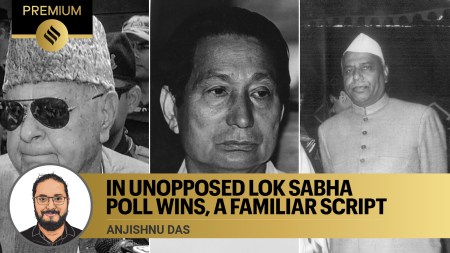
In unopposed Lok Sabha poll wins, a familiar script Subscriber Only

Campervan travellers are discovering off-the-grid vacays Subscriber Only
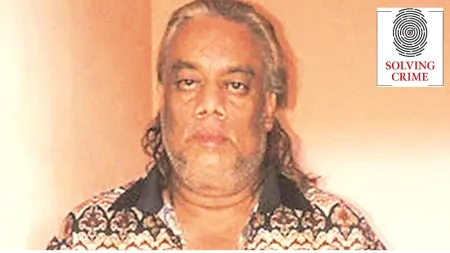
How Mumbai gangster was traced to Africa after he targeted Subscriber Only

AI-generated real-time calls to voters blur lines amid Lok Sabha Subscriber Only
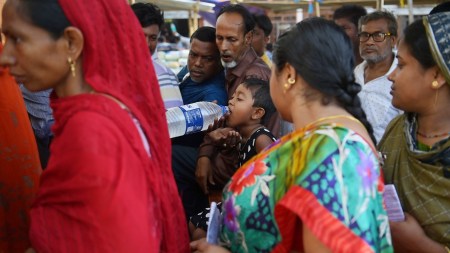
In election campaigns, not much talk of climate change Subscriber Only
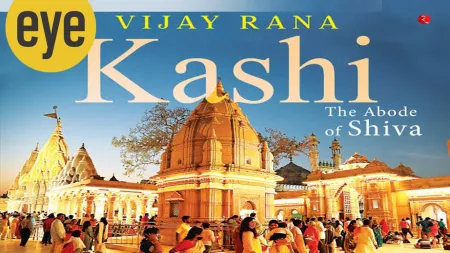
Vijay Rana's Kashi: The Abode of Shiva Subscriber Only

Paris Olympics: Reetika Hooda emerges as India’s brightest prospect Subscriber Only
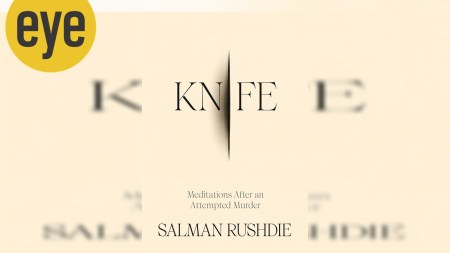
Knife: Salman Rushdie’s triumph over fate Subscriber Only
- Express Explained

The HPBOSE announced class 12 results today, which can be checked on the official website. The exams were held offline from Feb 12 to Mar 6. Results can be accessed by entering roll number. If the official website is down (hpbose.org), the students can check marks at education.indianexpress.com.

More Explained

Best of Express
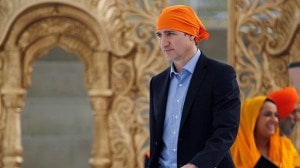
EXPRESS OPINION

Apr 29: Latest News
- 01 IPL 2024 points table update: Chennai Super Kings move to 3rd, Sunrisers Hyderabad drop to 4th
- 02 Archery: Korea had their big guns but Dhiraj and Co had belief as they stun powerhouses for World Cup gold in Shanghai
- 03 IPL 2024 Purple Cap update: Jasprit Bumrah still on top after KKR vs DC
- 04 BJP wants 400 seats to make changes in the Constitution: Sharad Pawar
- 05 Poll vault | Sanjay Raut: BJP ended up making Cong-yukt BJP
- Elections 2024
- Political Pulse
- Entertainment
- Movie Review
- Newsletters
- Gold Rate Today
- Silver Rate Today
- Petrol Rate Today
- Diesel Rate Today
- Web Stories

The Catholic Travel Guide
Chennai, India: Basilica of the National Shrine of Saint Thomas the Apostle
About saint thomas and chennai:.
Certainly the first Christian to visit India, Saint Thomas arrived here around 52 AD. We all know him by the nickname “Doubting Thomas” but upon putting his hands into the resurrected body of Jesus, he became an ardent follower and evangelizer.
The city of Chennai, formerly known as Madras, was founded by British colonialists in the 17th Century. After the end of colonial rule, the name was changed back to Chennai.
About the Basilica of St. Thomas in Chennai:
Thomas was martyred here on a hill at the outskirts of the city which is now known as “ Saint Thomas Mount .” His body was buried on the spot over which the present Basilica stands. Santhome Basilica has a 183 foot tall spire constructed in 1894. The Basilica was renovated in December 2004 and has a statue of The Blessed Virgin Mary, brought from Portugal.Stained glass windows showcase the story of St. Thomas and the wooden plaques depict the story of the last days of Christ. The main altar has the inspiring statute of Jesus Christ.
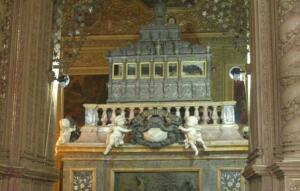
This is augmented by an informative museum with several important artifacts: the spear or the lance head that was used to kill St. Thomas, his fingerprint, an Episcopal chair, two postage stamps, inscriptions of his deeds on stones, the remains of his bones and wall paintings portraying St. Thomas’s life and death.
Traveling to Chennai:
Chennai is a fairly large city and is served by many airlines. There are flights connecting from the U.S. and Great Britain through major European cities.
Several airlines in the Middle East and Asia offer non-stop flights as well. From Australia there are several one-stop flights via Singapore or Kuala Lumpur.
Address: 38, San Thome High Road, Mylapore, Chennai, Tamil Nadu 600004
GPS coordinates: 13° 1′ 52.7916” N, 80° 16′ 38.1144” E
Tel: +91 44 2498 5455
The official website of the Basilica of the National Shrine of Saint Thomas in Chennai, India is not online at this time.

⇐ Back to Catholic shrines and places of interest in India
1 thought on “chennai, india: basilica of the national shrine of saint thomas the apostle”.
My husband and I will like to stay in a Catholic church accomodations for a week in the beginning of February of 2020
Leave a Comment Cancel reply
You must be logged in to post a comment.
- International edition
- Australia edition
- Europe edition
The incredible journey
The rains come to Kerala for months at a time. It is the greenest state in India: hot and humid, still and brooding. The soil is so fertile that as you drift up the lotus-choked waterways, the trees close in around you, as twisting tropical fan vaults of palm and bamboo arch together in the forest canopy. Mango trees hang heavy over the fishermen's skiffs; pepper vines creep through the fronds of the waterside papaya orchards.
In this country live a people who believe that St Thomas - the apostle of Jesus who famously refused to believe in the resurrection "until I have placed my hands in the holes left by the nails and the wound left by the spear" - came to India from Palestine after the Resurrection, and that he baptised their ancestors. Moreover, this is not a modern tradition: it has been the firm conviction of the Christians here since at least the sixth century AD.
In 594 AD, the French monastic chronicler Gregory of Tours met a wandering Greek monk who reported that, in southern India, he had met Christians who had told him about St Thomas's missionary journey to India and who had shown him the tomb of the apostle. Over the centuries to come, almost every western traveller to southern India, from Marco Polo to the first Portuguese conquistadors, reported the same story.
The legend of St Thomas led to the first-ever recorded journey to India by an Englishman: according to the Anglo-Saxon Chronicle, King Alfred (he of the burned cakes) sent Bishop Sighelm of Sherborne "to St Thomas in India"; years later, the bishop returned, carrying with him "precious stones and the odiferous essences of that country".
The stories that the travellers brought back with them varied little: all said how in India, St Thomas was universally believed to have arrived in AD 52 from Palestine by boat; that he had travelled down the Red Sea and across the Persian Gulf, and that he landed at the great Keralan port of Cranganore, the spice trading centre to which the Roman Red Sea merchant fleet would head each year, to buy pepper and Indian slave girls for the Mediterranean market.
In Kerala, St Thomas was said to have converted the local Brahmins with the aid of miracles and to have built seven churches. He then headed eastwards to the ancient temple town of Mylapore, now in the suburbs of Madras. There the saint was opposed by the orthodox Brahmins of the temple, and finally martyred. His followers built a tomb and monastery over his grave which, said the travellers, was now a pilgrimage centre for Muslims and Hindus, as well as Christians in southern India.
Although the historicity of the legend is unprovable, the modern St Thomas Christians - as they still call themselves - regard this tradition as more than a myth: it is an article of faith which underpins religious beliefs, identity and their place in Indian society. It is a tradition they go to extraordinary lengths to preserve and to propagate - not least by establishing what is almost certainly Christianity's only troupe of dancing nuns.
Moreover they are agreed - as are many of their Hindu neigh bours - that St Thomas is not dead: that he is still present in Kerala, guarding his followers and guiding his church. This was palpable at the small "miracle church" of Putenangadi, south of Cochin. At a time when the violent conflict between Hindus and Christians in north India was making headlines across the world, members of both faiths could be found side by side crammed into the same church, all convinced that St Thomas was present in the building to answer the prayers of his devotees.
At the back of his church, I came across an old Hindu woman named Jaya. I asked her why she chose to pray in a Christian church: "So that I can be relieved of all my troubles," she replied. "It is that faith that brings me here. If there's anything I need, I ask St Thomas for it."
"But, as a Hindu, why would you come to a Christian church?," I asked. "Why not go to the temple?" "Because I have faith," she repeated simply. "When I have difficulties, St Thomas solves them for me. Of course, I go to the temple too. But any big problem I have, I come here and I pray, and my prayers are always answered. For me, St Thomas is definitely alive."
Later, Jaya introduced me to her Christian friend, Miriam. "In my experience, praying to St Thomas here is always effective," said Miriam. "Whatever I need I pray for and my prayers are heard and answered. Of course, there is God, but it is St Thomas's name that we call. He is all I have."
The trail of St Thomas's journey to India begins thousands of miles from Kerala in the deserts of the Middle East. In the sixth century, the Byzantine empire was beginning to crumble under a wave of attacks, and the great classical cities of the east Mediterranean were falling into ruin and decay. As their libraries and universities were burned down or deserted, many of the most important manuscripts were preserved in the library of a remote monastery in the deserts of the Sinai now known as St Catherine's.
Its great walls and sheer isolation preserved it from attacks for centuries. Protected from their enemies, the monks accumulated one of the greatest treasuries of icons and illuminated manuscripts in the Christian world. Scholars who penetrated the region in the 19th century were astonished to find in the monastery a library of unmatched richness, containing lost works by great classical authors and the oldest extant copy of the New Testament.
But perhaps the strangest discovery of all was a previously unknown early Christian text dating from the fourth century AD entitled the Acts of St Thomas. The manuscript told a story that had been forgotten in the traditions of the western Church. According to the Acts, St Thomas was Jesus's twin (the Syriac for Thomas - Te'oma - means twin, as does his Greek name, Didymos); like his brother, he was a carpenter from Galilee.
After Jesus's death, according to the Acts, the apostle had been summoned to India - and his martyrdom - by a mysterious king, Gondophares. Biblical scholars of the 19th century were at first very sceptical of the Acts of St Thomas. They correctly pointed out that the story contained many clearly apocryphal Gnostic elements, and that the earliest surviving version of the text, written in fourth century Mesopotamia, dated from at least two centuries after the events described; up to the beginning of this century, the document was sometimes dismissed as a pious romance.
Nevertheless over the past 100 years, as research has progressed both into ancient Indian history and the links between India and the Roman Middle East, a series of remarkable discoveries have gone a long way to prove that the story contained in the Acts seems to be built on surprisingly solid historical foundations. First, British archaeologists working in late 19th-century India began to find hoards of coins belonging to a previously unknown Indian king: the Rajah Gondophares, who ruled from AD19 to AD45. If St Thomas had ever been summoned to India, it would have been Rajah Gondophares who would have done it, just as the Acts had always maintained.
The fact that the Acts had accurately preserved the name of an obscure Indian rajah, whose name and lineage had disappeared, implied that it must contain at least a nucleus of genuine historical information. Archaeological discoveries have since confirmed many other details of the story, revealing that maritime contacts between the Roman world and India were much more extensive than anyone had realised.
In the 1930s, Sir Mortimer Wheeler discovered and excavated a major Roman trading station on the south Indian coast, while other scholars unearthed references showing that in Thomas's time, the trick of sailing with the monsoon had just been discovered, reducing the journey time from the Red Sea to India to just under 40 days. According to a previously overlooked remark by Strabo, first- century geographer and historian, 200 Roman trading vessels a year were making the annual journey to the bazaars of Malabar and back.
More intriguing still, analysis of Roman coin hoards in India has shown that the Roman spice trade peaked exactly in the middle of the first century AD. All this showed that if St Thomas had wanted to come to India, the passage from Palestine, far from being near-impossible, would in fact have been easier, more frequent and probably cheaper than at anytime in the next 1,500 years - until Vasco da Gama discovered the sea route to the Indies in 1498.
Scholars discovered further confirmation of the Acts in the practices of the St Thomas Christians. Since the second world war, theologians have become increasingly aware of the Jewishness of Jesus and his first disciples: it has become apparent, for example, that the first Christians of the early church- those who knew Jesus and his teaching personally - would have carried on going to the temple in Jerusalem, performing sacrifices and circumcisions, and obeying the Jewish food laws.
If St Thomas had carried Christianity to India, it is likely that he would have taken a distinctly more Jewish form than the Gentile-friendly version developed for the Greeks of Antioch by St Paul and later exported to Europe. Hence the importance of the fact that some of the St Thomas Christian churches to this day retain Judeo-Christian practices long dropped in the west - such as the celebration of the solemn Passover feast.
Hence also the significance of the St Thomas Christians still using the two earliest Christian liturgies in existence: the Mass of Addai and Mari, and the Liturgy of St James, once used by the early Church of Jerusalem. More remarkable still, these ancient services are still partly sung in Aramaic, the language spoken by Jesus and St Thomas.
The more you investigate the evidence, the more irresistible is the conclusion that whether or not St Thomas himself came to India, he certainly could have. And if he didn't make the journey, it seems certain that some other very early Christian missionary did, for there is certainly evidence for a substantial Christian population in India by at least the third century.
And if there is no documentary proof to clinch the case, there is at least a very good reason for its absence: for the entire historical documentation of the St Thomas Christians was reduced to ashes in the 16th century - not by Muslims or Hindus, but by a newly arrived European Christian power: the Portuguese. As far as the Portuguese colonial authorities were concerned, the St Thomas Christians were heretics, an idea confirmed by their belief in astrology and reincarnation, and the Hindu-style sculptures of elephants and dancing girls found carved on their crosses.
Notions that they might also have maintained early Christian traditions predating the arrival of the faith in Europe were dismissed out of hand. The Inquisition was brought in, and the historical records of the St Thomas Christians put to the flame. Yet the old stories did survive, locked in the minds and memories of Christians in inaccessible Keralan backwaters.
In songs and dances passed on from father to son and teacher to pupil, they preserved intact many of their most ancient traditions. Scholars now believe that if the answer to the riddle of the legends of St Thomas lies anywhere, it is in this rich and largely unstudied Keralan oral tradition.
The man who has done more than anything to preserve this heritage is a plump catholic priest and village schoolteacher named Father Jacob Vellian. Working in isolation in his spare time, with little help and pitiful resources, Fr Jacob has since 1973 single-handedly travelled from village to village in Kerala systematically collecting Christian songs and dances about St Thomas's travels and exploits in India.
On two occasions, hidden in remote villages, he stumbled across palm-leaf books from the 16th century, which preserved other fragments of the songs and ballads in tiny Malayalam lettering: the oldest surviving documentation of the St Thomas Christians. There were, he discovered, still current in the Keralan countryside, hundreds of songs recording the deeds of St Thomas, as well two ancient full-length ballads, the older of which, The Margam Kali Pattu or Song of the Way, was of epic proportions.
Both these ballads predated the coming of the Portuguese and both, from their very archaic language, showed every sign of dating from the earliest centuries AD.
Almost everywhere Fr Vellian found the oral tradition on the verge of extinction, with the young people unwilling to carry on the job of learning by heart the complex stanzas. In several places he was able to record lost fragments of the epics just weeks before the last of the asans (or village bards) died, taking their songs to their grave. "Over the years I have tried to meet with every Christian asan in Kerala," Vellian told me. "Most of them were illiterate: isolated old men who were only barely aware of the importance of what they were clinging on to. Some had a few disciples and were very eager to teach what they knew; others had none. But no one was trying to write down what they had preserved. No one was promoting them or rewarding them for their work.
"As a result much must have been lost: not one asan knew the whole of the two longest ballads: some knew 20%; some 70%. But the 14 sections that we now have seems to be the whole of The Song of the Way, and the job now is to study this and to make sure it is passed on." To that end, Vellian has been building on another, almost lost Keralan tradition: the dancing nuns of Malabar. Fr Vellian has spent the last few years training up some of the many hundreds of nuns of Kerala to dance the ancient dances of St Thomas, and groups of wimpled sisters can now be seen swaying uncertainly to the beat of the tabla as they attempt to master the dances which tell of the apostle's travels. In this way, what may be the last surviving link with the tradition of the apostles is now being preserved by a group of south Indian Whoopi Goldbergs.
Fr Vellian is adamant that the oral traditions have accurately preserved a series of texts that may well hold vital clues which could help prove the St Thomas legend: "The palm-leaf documents that we have collected show how accurately the bards have preserved the text," he says. "Here or there a word may have changed, in the 300 years since the earliest was written down, but by and large the versions we have collected in the fields are consistent both with each other and these palm leaf-texts. These traditions are an authentic and incredibly valuable and ancient source of Christian history, and should be respected as such."
Vellian is right. For while Christianity has never been a major faith in India, it is a religion with deep roots, which has clung on with incredible tenacity, despite all the odds. Above all, the church here has remained faithful to the tradition of St Thomas's journey from Palestine to India. It is a story long forgotten in a west which has come to regard itself as the true home of the faith, forgetting that in essence, Christianity is an eastern religion.
Before leaving Kerala, I asked Dr Vellian whether he really believed his work would eventually provide some conclusive evidence to prove St Thomas's journey. "In the end, we are the evidence," he said. "We have a very ancient, unbroken tradition that St. Thomas was the founder of the church in India. Our traditions are unanimous that he came here, and that is something we have held on to, despite persecution, for 1,700 years. Our spirituality is very close to that of the early church and we believe our church is as old as any Apostolic Church in the world. Our songs and traditions are quite clear about this. In the end it is these traditions that we base our belief on: not something on paper or stone which is secondary. It is our fidelity to St Thomas that is most important to us."
Most viewed
- The arrival of St. Thomas
_large.jpg)
Certain legends The visit of St. Thomas is still a matter of dispute among historians. There are only very limited details about him in the Bible. He appears thrice in the Gospel of St. John (St. John 11:16, 14:5, 20: 25-29). The three occasions are the resurrection of Lazar, the Last Supper, and the resurrection of Christ. In the gospel, he is named as Thomas who was known as Didymus. There are no written references to his gospel activities. The oldest document in this score is the book Acta Thomae, written at Edessa in CE 2- 4 centuries. This book came to be written since some traders took the body of St. Thomas to Edessa. A Syrian scholar is said to be the author of this book set against the cultural background of Mesopotamia. As per the descriptions in this book, St. Thomas, on his first mission, reached the capital of the Parthian King Gondophares, who ruled Afghanistan and Punjab with Takshasila as capital, along with the trader Abbanes, and on his second mission, he travelled to a kingdom in South India ruled by a 1st Century dynasty. According to tradition, St.Thomas evangelized this area and then crossed over to the Coromandel Coast of Southeast India. He was killed while he was carrying out his mission at Mylapore near Madras. His body was laid to rest there and subsequently moved to Edessa in the fourth century and from there to Orthano in Italy.
_large.jpg)
The Kerala tradition links him with certain families and the founding of churches in certain places. The Christians of Kerala endorse it. Books like Veeradiyan Pattu, Margam Kali Pattu , and Ramban Pattu , that describe the Kerala tradition reiterate the founding of the Churches. The stanza, starting with “Arul Margathil” in Ramban Pattu, says that St. Thomas boarded a ship from Arabia and reached Maliyankara. Marco Polo has recorded that he visited the tomb of St. Thomas in Mylapore. It was the site of the saint’s martyrdom and had become a centre of pilgrimage for Christians and Muslims. Certain Historical Facts The mortal remains of St. Thomas were taken to Edessa and conserved in a church named after him, says Mar Ephrem (CE 363) in his book, Parishudhatmavinte Veena , written in Syriac. Mar Ephrem, who was born in Nisibis, spent his last days in Edessa. The remains were taken to Italy along with the mortal remains of martyrs from the Middle East, during the holy war. The bone of the right hand was brought to India with the permission of the Vatican. This is conserved at the church in Azhikode in Kodungalloor where St. Thomas first arrived in a ship.
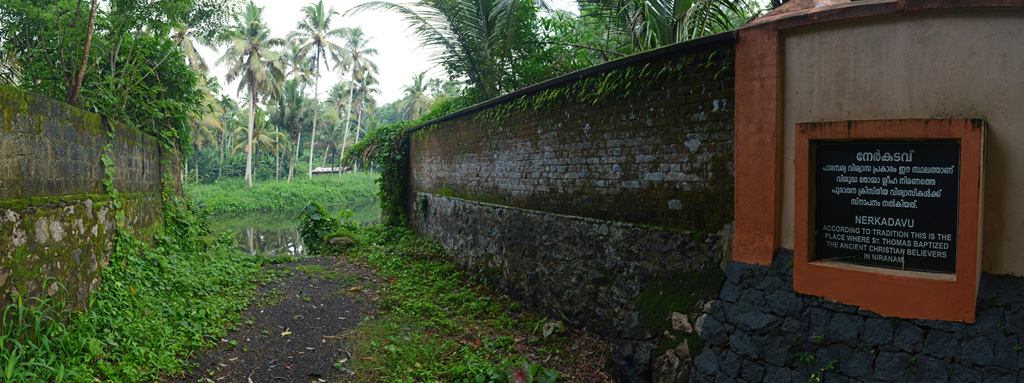
Earlier, the gospel activities of St.Thomas in North India, as well as Gondophares were considered as mere fiction. The existence of this King has now been established by the coins recovered from Punjab, Sind, and Afghanistan ( A. E. Medylcott, India and the Apostle Thomas ). Dr. Bellew recovered a stone scripture, kept in the Lahore Museum, about the Parthian empire ruled by Gondophares. This stone scripture is known as Takht-i-Bahi stone. The regime of Gondophares begins in CE 46, i.e. during the first half of the First Century ( Kudapuzha, Xavier, The History of Indian Church ). This agrees well with the period of St. Thomas’s visit to India. During 1289, sent by Pope Nicolas IV to India and China, John of Monte Carvino, a Franciscan friar, visited the Coromandel Coast and stayed in India for 13 months. He also stayed at San Thom where the tomb of St. Thomas stands ( Yule, Henry and Cordier, Henri, Cathay and the way Thither ). John of Marignolli, who visited India in CE 1348, has written about the Christians in Kollam. Nicholas de Conte, an Italian merchant, has described his visit to the tomb in CE 1441 and also about the Nestorians and Jews in Malabar ( Major, R. H., India in the Fifteenth Century ).
- Tradition of origin Tradition of origin Tradition of origin
- Classical period
- Portuguese contact
- Division and defiance
- British period
- The Tradition of St. Thomas
- Seven and half Churches
- Post St. Thomas arrivals
- The scenario before the arrival of Gama
- Missionary Activities
- Descriptions of St. Thomas Christians
- The Padruodo
- Portuguese Forts
- Synod of Diamper
- Latinization of Churches
- Coonan Cross Oath
- Post Koonan Kurissu
- Establishment of churches
- Starting of Seminaries
- Anglo Indians
- Migrations to Malabar
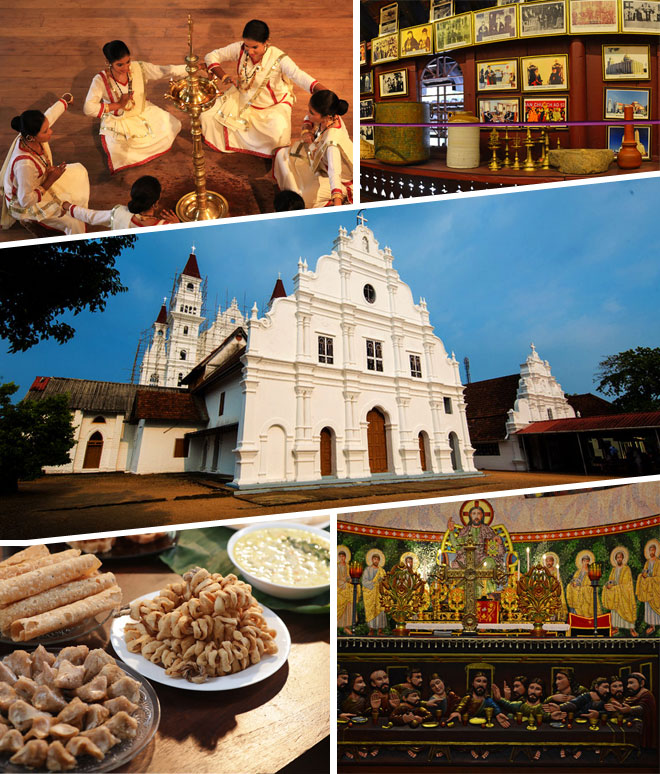
How to go to Heaven
How to get right with god.

Did the Apostle Thomas take the gospel all the way to India?
For further study, related articles, subscribe to the, question of the week.
Get our Question of the Week delivered right to your inbox!

- Call us: 020 7640 0042
St Thomas the Apostle and Christianity in India | Catholic Truth Society
- Basket Basket 0 £ 0.00
St Thomas the Apostle and Christianity in India
The Christian heritage of South Asia stretches back to the time of the Apostles. Discover the history of St Thomas the Apostle, St Francis Xavier and the evangelisation of the region.
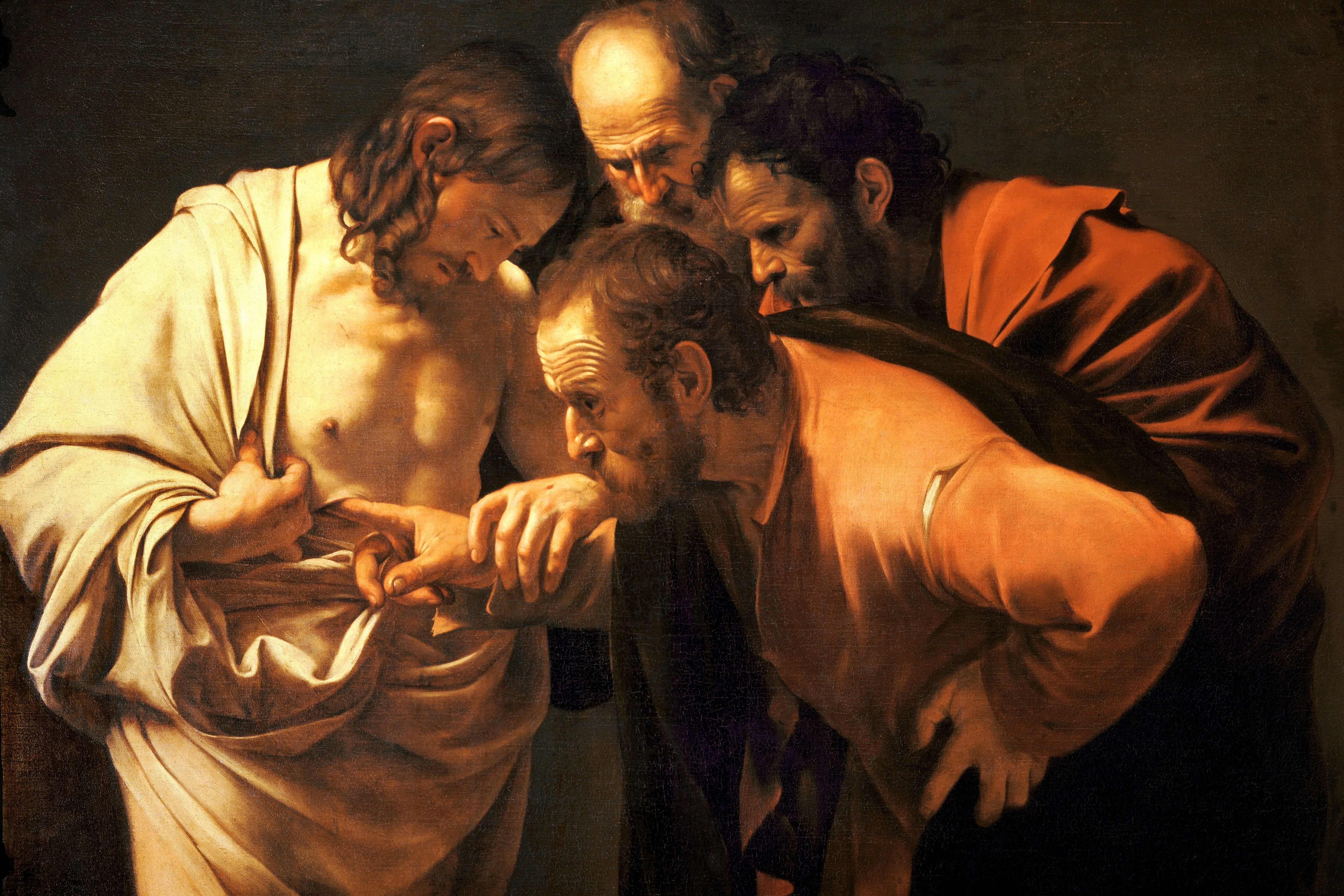
Faith , Saints , Talking Points , On 3rd July 2023 by Jean Olwen Maynard
From the Day of Pentecost, Jesus’ followers set out to fulfil his commission of announcing the Gospel “to all the nations”. The Christian message travelled out in every direction, by land and sea, along the trade routes of the ancient world, everywhere finding previously-established Jewish diaspora communities which served as entry points . Vibrant Christian networks spread throughout the Middle East, where the lingua franca was Syriac (a form of Aramaic, as spoken by our Lord and his disciples), and soon crossed the Roman imperial frontiers to spread into the Arabian peninsula and the Persian Empire, forming what would become the Church of the East. To the west, Christianity gained a toehold in Greek-speaking cities all around the Mediterranean: the career of St Paul, as documented in Acts, is just one example of a much wider process.
Another sea route known to traders from the Roman Empire went via the Red Sea into the Indian Ocean, where a canny captain could pick up the monsoon winds and ride them to the Malabar Coast , the south-west coast of India, to return laden with jewellery and spices. Several Jewish communities are known to have been established in India, and it’s highly likely that the route was also taken by Christian emissaries.
According to a long-established tradition the faith was brought to India by the Apostle Thoma s, believed to have reached the Malabar Coast in 51 AD: he landed at the ancient port of Muziris, near Kodungallur in present-day Kerala, and after planting and nurturing seven churches, sailed around to the east coast to die a martyr’s death at Mylapore, Chennai (Madras). The apocryphal Acts of Thomas tells an alternative story of the Apostle travelling to northern India at the invitation of King Gundaphar – and archaeological discoveries showing that Gundaphar actually existed, and probably had his capital in Taxila, an ancient city not far from present-day Islamabad, suggest there might be a grain of truth in that story. However no evidence has been found of any Christian community in the north, whereas in Kerala the “St Thomas Christians” have been a living presence to this day.
Keeping the Faith
Towards the end of the second century St Pantaenus, an intellectually brilliant Jewish convert to Christianity, and principal of the famous Catechetical School of Alexandria in Egypt, accepted an invitation to travel to India to engage in dialogue with the Hindu philosophers. While he was there he met up with the local Christians, and was shown a Hebrew copy of the Gospel of Matthew. In 345 AD another Thomas arrived in Kodungallur . This was Thomas of Cana, leader of a well-organised group of Christian families, accompanied by clergy. They had fled as refugees from Persia, where thousands of their co-religionists were suffering martyrdom in a ferocious persecution.
The newcomers quickly made contact with the local Christians, revitalised their community, helped them become better organised, and established regular contact between them and the Church of the East – though, sadly, it was not long after this link-up that Communion was broken between the Church of the East and the Sees of Rome and Constantinople. The Malabar churches adopted Syriac as their liturgical language, and were placed under the jurisdiction of a bishop on the Persian Gulf. Five stone crosses have been found in India which date back to the first millennium. Similar crosses found in Sri Lanka point to there also having been a small Christian community there, though it did not survive for longer than a few generations.
Over time the St Thomas Christians came to be regarded as, and function like, a caste within the Hindu system. As such they enjoyed high status, being valued by local rulers as brave and loyal warriors, though the downside of this was that it discouraged them from evangelising, since bringing outsiders into the community would have undermined their social standing. In the thirteenth century, the Mongol conquests established strong, unified rule over vast stretches of the Eurasian landmass, thereby making possible the reopening of long-distance communication. Roman Catholic missionaries then began to be sent out from Western Europe deep into Asia, and John of Montecorvino, a particularly intrepid Franciscan, spent a year in India with the St Thomas Christians while on his way to China. But a century later the Black Death swept the world, travelling like the missionaries along the trade routes, and closing them down once again.
In search of Christians and spices
In 1497-98 a Portugese expedition, led by Vasco da Gama, sailed round Africa into the Indian Ocean to land on the Malabar Coast, announcing that they’d come in search of “Christians and spices”. Another objective was to encircle and wage war against the Muslim world, and as soon as this became apparent it sparked conflict. The Portuguese were nevertheless welcomed by the Hindu Rajah of Kochi, an important trading centre for black pepper quite close to Kodungallur. They built a fort and a church in Kochi, and drove out the local Muslim traders, which delighted the St Thomas Christians as it allowed them to take over the lucrative pepper trade.
The Portuguese proceeded to conquer the island port of Goa, expelling its Muslim rulers and developing it into the administrative and ecclesiastical headquarters of their developing maritime empire. Armed aggression also won them the city of Bassein and the nearby islands of Mumbai (Bombay). However, as a small country with limited manpower, Portugal had no chance of forcibly occupying anything more than small enclaves around strategic points. Raw courage and daring made Portuguese troops a formidable fighting force, but they had no superior weaponry to give them a decisive edge other than their heavy guns – cannons – which mostly had to stay mounted on their ships and forts, because they were so difficult to transport. The cannons gave them easy command of coastal areas, but left them relatively powerless a few miles inland.
In any case, aggression wasn’t always necessary. Although some local rulers saw the Portuguese as a threat, others saw them as attractive potential allies and trading partners. I n many places, therefore, peaceful negotiation proved more cost-effective. Along the eastern coast of India it gained them a warm welcome, and permission to establish a whole string of trading settlements, from Tuticorin in south-east Tamil Nadu all the way up to Chittagong, principal port of the wealthy Sultanate of Bengal. The King of Kotte, in Sri Lanka, also made friendly overtures and invited them to establish a fort at Colombo. Kotte was one of several Sinhalese Buddhist kingdoms in the southern part of the island, while the northern part was ruled by the Tamil Hindu King of Jaffna.
St Francis Xavier
The first Jesuit missionary, St Francis Xavier, arrived in Goa in 1542 and used it as a base for travelling around the region. He is particularly remembered for consolidating the nascent Christianity of the Parava fishworkers who operated the pearl fisheries between Kanyakumari, at the southernmost tip of India, up to Tuticorin. The Paravas had readily agreed to be baptised in return for Portuguese protection from Muslim raiders, but before Fr Xavier’s arrival they hardly knew anything about the faith they’d committed themselves to . Fishing communities on the island of Mannar off Sri Lanka, hearing about his work among the Paravas, sent a message asking him to come and preach to them too: he was unable to go personally, but sent another priest instead.
When in 1544 the King of Jaffna, infuriated with the Portuguese, decreed a crackdown on Christianity, the Mannar converts refused to renounce their new-found faith, and some six hundred men, women and children died as martyrs . After Fr Xavier’s death in the Far East, in 1552, his body was brought back and enshrined in Goa: he was canonised in 1622.
Further large-scale accessions to Christianity began to take place in Sri Lanka from around the middle of the sixteenth century, especially among the fishing communities just north of Colombo. Members of royal families also began asking for baptism , and this encouraged conversions among the Sinhalese nobility, but also provoked a Buddhist backlash and weakened the kingdoms politically so that they fell increasingly under Portuguese domination. Following a successful military expedition to conquer Jaffna, the Portuguese came to control most of the coastal areas, though the thickly forested interior remained independent under the Buddhist King of Kandy.
Setbacks and Challenges
In and around the Portuguese bases, European soldiers and traders settled down and married local women, giving rise to a mixed-race population which formed the nucleus of a Christian community wherever there was not one already. Elsewhere, conversions were few. South Asian rulers, whether Hindu, Muslim or Buddhist, often proved far more tolerant of efforts to spread an alternative belief system among their subjects than any Christian government in Europe would have been at the time; nevertheless, the growing numbers of Christians were overwhelmingly concentrated in the areas under Portuguese rule. The Pope had agreed that all missionaries should be sponsored and controlled by the Portuguese government: this had been logistically advantageous to begin with, but as time passed the disadvantages became increasingly apparent.
Something else that posed a serious problem for would-be evangelisers was the caste system. Most of the recent converts belonged to lower castes, so higher-caste Hindus tended to look down on Christianity as a low-caste religion.
Even the St Thomas Christians were anxious not to be too closely identified with the lower-caste converts. Tensions also began to mount between them and the Portuguese, due to the rigid-minded efforts of European missionaries to suppress their ancient liturgical and spiritual traditions and replace them with what they saw as the right way of doing things – that is, the Portuguese way. In 1599, at the Synod of Diamper, their own leadership was set aside and a Roman Catholic bishop imposed, and wholesale anathemas pronounced against everything about them that was different.
The tensions came to a head in 1653, when many of the St Thomas Christians resolved to reject Papal authority altogether, while others appealed to the Pope to send emissaries who would be genuinely neutral, and able to broker a just solution. The Pope then sent out Carmelite Fathers, and they were successful in reconciling the majority of the St Thomas Christians, whose descendants today comprise the Syro-Malabar Church, the second-largest Eastern Church in Communion with Rome.
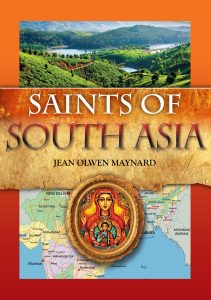
This blog is extracted from Saints of South Asia , which explores the history of St Thomas the Apostle, St Francis Xavier and the evangelisation of the region, along with information on how the people of these regions developed and defended their strong Christian faith.
Learn more about the legacy of St Thomas and encounter some of the many incredible saints of the region by ordering your copy of Saints of South Asia .
Find out more....
This blog is an extract from Saints of South Asia
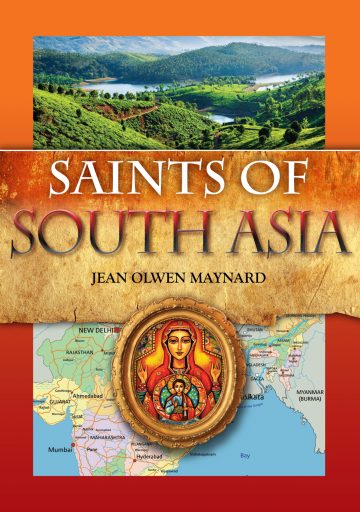
Saints of South Asia Jean Olwen Maynard
£ 3.50 • Add to Basket
- Thomas, the Novel
- Thomas, the Man
- Joseph the Teacher
- Travels of Thomas
- Jesus the Gatherer
- Srinigar in Himalaya
- Gospel of Thomas
- About the Author
- To Order a Copy
Thomas in Parthia and India
Thomas in parthia.
Thomas traveled much further than any other apostle. He left Jerusalem a week after the Pentecost where the apostles received the gift of tongues, and he never saw any of them again.
Thomas left Jerusalem with Habban as an indentured servant in the employ of Gundaphorus of Parthia as a carpenter and architect. Thomas in Parthia establ
Thomas left Jerusalem with Habban as an indentured servant in the employ of Gundaphorus of Parthia as a carpenter and architect. Thomas in Parthia established many Christian communities during the ten years he lived there before he went to India.
In those days, Parthia was the general name given to all the land between the Tigris/Euphrates valley and the Indus River. All lands east of the Indus river were called India, including China.
Thomas in India
Thomas established Christian communities along the western and eastern shores of (modern-day) India, and many of those are still going strong.
Thomas was martyred in Mylapore, Chennai, on the Bay of Bengal in the south of India. Many streets in that area today bear the name of Thomas.
The author of Thomas the Apostle lived and worked in C
The author of Thomas the Apostle lived and worked in Chennai and learned many stories of Thomas that friends were delighted to relate, stories they had heard from their parents and grandparents.
The name of the city of Madras was changed to Chennai in 1996 while the author lived there.
Friends of Thomas
This novel also tells many stories of:
James and Levi, sons of Alphaeus and older brothers of Thomas
Nathanael, often paired with Thomas while they studied together under Jesus
Essenes, where Thomas spent many happy years.
John the Baptizer, whose disciples included Thomas.
The man from India who followed Jesus as a disciple and was l
The man from India who followed Jesus as a disciple and was later renamed as
Jesus the Gatherer
since he gathered the stories of Jesus and took them back to India.
Copyright © 2024 Thomas the Apostle - All Rights Reserved.
Powered by GoDaddy
APOSTOLIC PILGRIMAGE TO INDIA
ADDRESS OF JOHN PAUL II ON OCCASION OF THE VISIT TO SAINT THOMAS MOUNT
Madras (India) Wednesday , 5 February 1986
Dear Archbishop Arulappa, Dear Brothers and Sisters of Madras, "Let us also go, that we may die with him" .
With these words, Saint Thomas showed his desire to be with Jesus, even in the face of death. At the same time, Saint Thomas spoke these words to the other disciples to inspire in them a similar love for Jesus, to stir up in them the same courage and devotion.
"Let us also go, that we may die with him".
According to tradition, at this very place, which is now called Saint Thomas Mount, the great Apostle of India fulfilled his own exhortation. Out of love for Jesus, here in Madras, Saint Thomas died for Christ. He gave his life as a martyr for the sake of Christ and the Gospel.
Dear friends in Christ, and you especially, dear children: let us ask God for strong faith and courage. Let us love Jesus as Saint Thomas did. Let us offer him our lives day after day, so that we may live with him for ever.
© Copyright 1986 - Libreria Editrice Vaticana
Copyright © Dicastero per la Comunicazione - Libreria Editrice Vaticana
The Complete Pilgrim - Religious Travel Sites
Howard Kramer's, The Complete Pilgrim, Religious Travel Site
BASILICA OF ST. THOMAS
June 1, 2014 By Howard Kramer 10 Comments
Chennai, Tamil Nadu
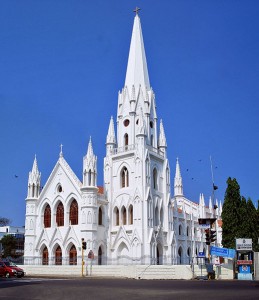
(photo from Wikipedia)
The Basilica of St. Thomas in India is one of the most important churches in Asia and yet one of Christanity’s least well-known major shrines. This is due in large part to geography, as it is strange to think that a small Christian enclave thousands of miles to the east of the Holy Land and Europe is in possession of one of only a handful of known apostolic tombs. Nevertheless it is arguably the second most likely true apostolic tomb after that of Peter, though most of Thomas’ corpse was removed many years ago. Thanks to Chennai’s increased importance as one of India’s largest business centers, this long-forgotten shrine is now becoming a major destination for Christian tourists in India. Today the Basilica is the top tourist site in eastern India for visiting Christians.
Thomas was one of the twelve Apostles that accompanied Jesus during his ministry in Galilee. Although one of the less important Apostles from the Biblical narrative, his disbelief concerning Jesus’ resurrection after the crucifixion was one of the most memorable moments in the New Testament. According to tradition, it was because of Thomas’ disbelief that he drew the lot that required him to travel to the distant lands of the east. The Apocryphal books of Thomas are among the most extensive, and because of this we have more clues concerning Thomas’ later life than almost any of the other Apostles except perhaps Peter.
There are several variations of the stories of Thomas’ travels following the Apostolic Diaspora, not necessarily mutually exclusive. All versions agree that he did go east, spending some time in Eastern Syria and Persia before continuing on to India. Although this may seem geographically improbable, there is certainly evidence of a Christian community of Syriac origin in India dating possibly as far back as the 2nd century AD. As the story goes, Thomas arrived in India around 52 AD, possibly as the slave of a Persian monarch or trader. Thomas set about establishing a church, and soon the region boosted a sizeable Christian community. He continued to live and preach among the Indians for almost a quarter of a century, probably outliving most of the other Apostles.
Unfortunately, Thomas was not destined to escape the violent fate of his brethren. After years of living in peace, anti-Christian elements of the local community finally decided that Thomas’ following had grown dangerously large. Thomas was chased out of his long-time cave home and pursued to the top of a mountain where he was caught and pierced through the heart with a lance. After his death, his body was taken back to the town and buried. Although it can be assumed that the rest of the Christian community also suffered persecution, virtually nothing is known with any certitude, even from Apocryphal documents.
Some time after his death, a church was built on or near Thomas’ grave. This was replaced by a larger shrine around the 6th century AD, probably by Oriental or Assyrian Christians. Portuguese explorers and missionaries discovered the shrine in the 17th century and replaced it with a Catholic structure. The tomb containing Thomas’ relic, or at least part of it, was preserved within. Another tradition suggests that Thomas’ body may have been moved in whole or in part back to Edessa sometime in the 4th century, and thence to Ortona in Italy. In all likelihood the body has long since been split up, as was common practice at the time. Today the Basilica of St. Thomas is highly venerated as both the holiest Christian site in India as well as one of the world’s only surviving Apostolic burial sites.
The various shrines of Thomas that have stood on this spot have gone through many makeovers and reconstructions throughout the centuries. The first major church was completed here by the Portuguese in 1606 AD. The current Basilica of St. Thomas was rebuilt at the end of the 19th century, and while it is a beautiful structure in and of itself, it somewhat lacks the venerable and majestic feel of other such basilicas. Although technically a neo-Gothic structure, the white brickwork and substantial number of stained-glass windows give the Basilica of St. Thomas a considerably less-than-gothic feel. A small museum at the church possesses Christian and colonial antiquities, which date from the Portuguese period.
The Basilica’s highlight, of course, is the Apostle’s Tomb. However, even the cathedral’s caretakers disagree as to what is actually contained within. Some hold that Thomas’ body is still there, while others believe that it has long since been removed and sent to Edessa or Ortona. In all likelihood a bit of the body resides in each location. The shrine chapel is located beneath the main church sanctuary, and is accessed by a separate entrance from the outside. The sarcophagas where Thomas’ relic was interred is still within, and has not been opened for almost three hundred years.
The Basilica of St. Thomas is located in the Mylapore district of Chennai, about six miles south of downtown and close to the Bay of Bengal. It is open every day from 6:00am-6:00pm. There is no cost of admission. Web: www.santhomechurch.com (official website)
Other Sites
Thomas spent the last twenty-five years or so of his life in the area around Chennai. While his tomb is in the Cathedral, he actually lived outside of the city on Little St. Thomas Mount . A cave on the hillside has been identified as the Apostle’s home, and a cross and some handprints are attributed to him. Two churches, a 16th century Portuguese structure and the 20th century Our Lady of Health , commemorate Thomas’ life here. In his last days, when Thomas was attacked by a mob, he fled to the nearby Greater St. Thomas Mount . Here he was caught and killed. Another 16th century Portuguese church was built over the spot where he died. Inside is the highly venerated Bleeding Cross, which is said to turn red every year on the saint’s Indian feast day.
About Howard Kramer
Howard Kramer is the creator and author of The Complete Pilgrim. He first took an interest in religious sites in his early twenties when traveling through Italy after college. In the two decades since he has traveled to more than two dozen countries and almost every state, visiting and photographing hundreds of the world’s greatest churches, synagogues and other places of religious interest. Howard has been writing about religious sites for the better part of the last decade, and The Complete Pilgrim is a culmination of years of his work and passion.
September 9, 2020 at 2:47 am
Nice Job dude,your guide helped me a lot
November 16, 2020 at 9:13 am
October 19, 2019 at 11:22 am
this will be surely a guide for visiting st.thomas basilica,chennna I HAD WENT TO ST.THOMAS BASILICA,CHENNAI…….. BEST PLACE…. SIR,YOUR GUIDE WAS HELPFUL FOR ME ….. THANKS A LOT….
October 20, 2019 at 2:33 pm
You are welcome!
August 24, 2019 at 11:37 pm
Interesting read. I was a this church/shrine many years ago. Being Catholic, I was totally drawn into the story of st. Thomas. I was also told his body lay right under the church many years ago, until it was sent to the Vatican for further DNA testing. Now I read that his body was split up and sent elsewhere. Who knows what the real story is!
September 22, 2019 at 8:01 pm
I would give anything to have the full history of what happened to all of the major New Testament figures after the Ascension.
November 14, 2018 at 8:29 pm
I WANT TO PRAY
December 6, 2018 at 9:10 pm
Glad TCP inspired you
September 3, 2018 at 10:20 am
September 12, 2018 at 8:13 pm
Leave a Reply Cancel reply
Your email address will not be published. Required fields are marked *
This site uses Akismet to reduce spam. Learn how your comment data is processed .
Where would you like to go?
Have a comment, a great photo or a religious site you'd like to nominate for the weekly spotlight? We would love to hear from you. Email us at [email protected].
About the Author
Academia.edu no longer supports Internet Explorer.
To browse Academia.edu and the wider internet faster and more securely, please take a few seconds to upgrade your browser .
Enter the email address you signed up with and we'll email you a reset link.
- We're Hiring!
- Help Center

St. Thomas tradition in India: a critical inquiry

This paper which was originally presented as part of my Christian studies as a major paper, aims to carefully look at the various reliable evidence for the existence of the St. Thomas tradition in India. It also considers the various historical and social data pertaining to and supporting the plausibility of the veracity of the St.Thomas Tradition in India.
Related Papers
2. Pius Malekandathil,”Debate on the Apostolate of St.Thomas in Kerala: A Response”, in Journal of St.Thomas Christians, vol. 29, no.2, July-December , 2018, pp.32-58
Pius Malekandathil
In recent days there appeared a controversy on the apostolate of St. Thomas in India. In fact the controversy was not only on the apostolate of St. Thomas alone, but also on some of the essential aspects linked with the very identity and consciousness of the St. Thomas Christians, who form one of the most vibrant Christian segments in Asia with around 50 lakh members. The central aspects of the controversy revolved around three questions: Did St. Thomas really come to India? How can one say that St. Thomas converted Nambuthiri Brahmins to Christianity as Nambuthiri Brahmins appeared only by 8 th century? The third point around which the controversy arose was on the sense of 'superiority' that some members of the St. Thomas Christians are alleged to uphold claiming 'Brahminical connections'. Initially I would like to say that these are three different issues and are to be analyzed separately, even though they may outwardly give the impression that they are linked with one another. No, they are not interlinked with one another. The seemingly woven interconnectedness among these three issues by different oral and family traditions added further confusion among both the historians and the ordinary people. Hence attempts are made here to look into these questions one by one, but separately and try to find clarity from a historical perspective
Avg Krishnan
Christians have been spreading that gospel tales Hero - Jesus the dead man's disciple one Thomas came to India and this is an Historical analysis
Orientalia Christiana Cracoviensia
Jan Zelazny
The Harp: A Review of Syriac and Oriental Ecumenical Studies, XXIV: 189-217
István Perczel
Joshua Robert Barron
Indian Christianity is an important part of the story of World Christianity that began with the Apostle Thomas. The texts in this bibliography tell some of the stories of Christianity in India. This bibliography provides a substantial introduction to Indian Christianity, but is not exhaustive in scope. Only monographs and edited volumes are included; adding individual chapters or academic articles would require at least hundreds of pages. Most titles listed are in English; a few are in other European languages. Titles in Indian languages such as Malayalam, Tamil, Hindi, Bengali, Gujarati, Urdu, Telegu, Marathi, Punjabi, and Assamese (among others) are not included: those who can read one or more of those languages most likely do not need to refer to a bibliography such as this! [latest revision: 29 November 2023]
Christianity in India: A Select Bibliography
Dr. Jayabalan Murthy
Did you know that the apostle Thomas reached India? The likely date for his arrival in the Indus River Valley was 40 AD. Gondophares, whom Thomas evangelized, was the king of a Hellenistic Indo-Parthian kingdom there in what is now Pakistan and westernmost India, reigning from 19-46 AD. Thomas was probably in South India no later than 52 AD. Some of the later traditions of the fourth century Thomas of Cana, a Syrian or Persian missionary to the Malabar Coast, have likely been conflated with the older traditions about the apostle, but the evidence for Thomas serving as a missionary in India is every bit as strong (and perhaps stronger) than the evidence that Peter went to Rome. Communities of "Thomas Christians" remain among the oldest continuous Christian communities in the world.
Samuel D Stephens
The Indigenous Church is rapidly growing in India. This article provides a brief historical perspective of the inception of the Indigenous Church dating back to the very first century A.D. The Indian Indigenous Church finds its roots in the "Thomas Tradition" attributed to The Apostle Thomas who is believed to have proclaimed the Gospel first In India.
Parole de l’Orient
Sunish George J. ALUMKAL
This paper presents the results of research on the Pesaha tradition of Saint Thomas Christians of India (Mar Toma Nasranis or Nasranis) in the context of its socio-cultural aspects. Pesaha is a tradition observed by the Nasranis at home on Maundy Thursday. This practice is observed with piety and has been preserved even after centuries of European influence. This is a unique tradition of Saint Thomas Christians and it is not known to be practiced by any other Christian community in India and abroad. The paper contains details of the Pesaha tradition and associated rituals and practices. The paper also provides an analysis of this tradition and compares its characteristics to that of the Jewish Passover. The paper also attempts to find out the origin of this practice. 1) The recent discovery of an ancient harbour in Kerala, India indicates the presence of Roman, Greek and Middle Eastern communities on the Malabar Coast even before the Christian era. This might point to the presence of early Jewish settlements in Malabar. 2) From literature it is clear that early Jewish Christians, particularly Aramaic speaking Christians, practiced several Jewish rituals including Passover up to the fourth century. 3) An ancient copper plate issued to the Nasranis by the local ruler indicates cooperation between Nasranis and the Jews of Kerala. These lead us to the conclusion that the Pesaha of Nasranis could be traced back to an ancient Syriac Christian practice or it might be the influence of early or later Jewish converts on the Malabar Coast.
in St.Thomas Christians and Nambudiris, Jews and Sangam Literature: A Historical Appraisal, ed.by Bosco Puthur, Kochi, 2003, pp.1-48
RELATED PAPERS
recuperoeconservazione_magazine
Simona Belmondo
Masliyanie Masliyanie
Solrun Oladottir
Jaroslaw Tegowski
Sebastiao Cronemberger
Current Neurovascular Research
Giovambattista Sarro
Molecular Pharmaceutics
Blanka Sharma
Rodrigo Dullius
Muhammad Kashif Khurshid
Paulo Alexandre Monteiro de Figueiredo
Epilepsia Open
Frank Tennigkeit
Bhalerao Khairnar
Current Issues in Criminal Justice
Samantha Jeffries
School Psychology Review
Cynthia Riccio
Chemical Engineering Journal
Teresa Castelo Grande
Journal of Vacuum Science & Technology A: Vacuum, Surfaces, and Films
Joy Perkinson
Molecular and Cellular Endocrinology
Pierre Lavigne
Linda Tumimba
citra resita
Physical Review Letters
Reinhold Schuch
gaelle dumas
Scientia et Securitas
Károly Kocsis
Italian Journal of Animal Science
Dariusz kokoszyński
Tạp chí Khoa học và Công nghệ Biển
Nguyễn Hạnh
Optics Communications
Jakob Stamnes
- We're Hiring!
- Help Center
- Find new research papers in:
- Health Sciences
- Earth Sciences
- Cognitive Science
- Mathematics
- Computer Science
- Academia ©2024
Tomb of St Thomas the Apostle
Chennai (Madras)
Behind San Thome Cathedral is the entrance to the weirdly chintzy tomb of St Thomas the Apostle.
It's believed that, in AD 52, 'Doubting Thomas' introduced Christianity to the subcontinent, before being martyred at St Thomas Mount , Chennai, in AD 72. Most of his mortal remains are believed to now be in Italy, but a small cross on the chapel wall containing a tiny bone fragment is labelled 'Relic of St Thomas'.
Santhome High Rd. Mylapore
Lonely Planet's must-see attractions

Arjuna’s Penance
29.15 MILES
The crowning masterpiece of Mamallapuram’s stonework, this giant relief carving is one of India's greatest ancient artworks. Inscribed on two huge,…
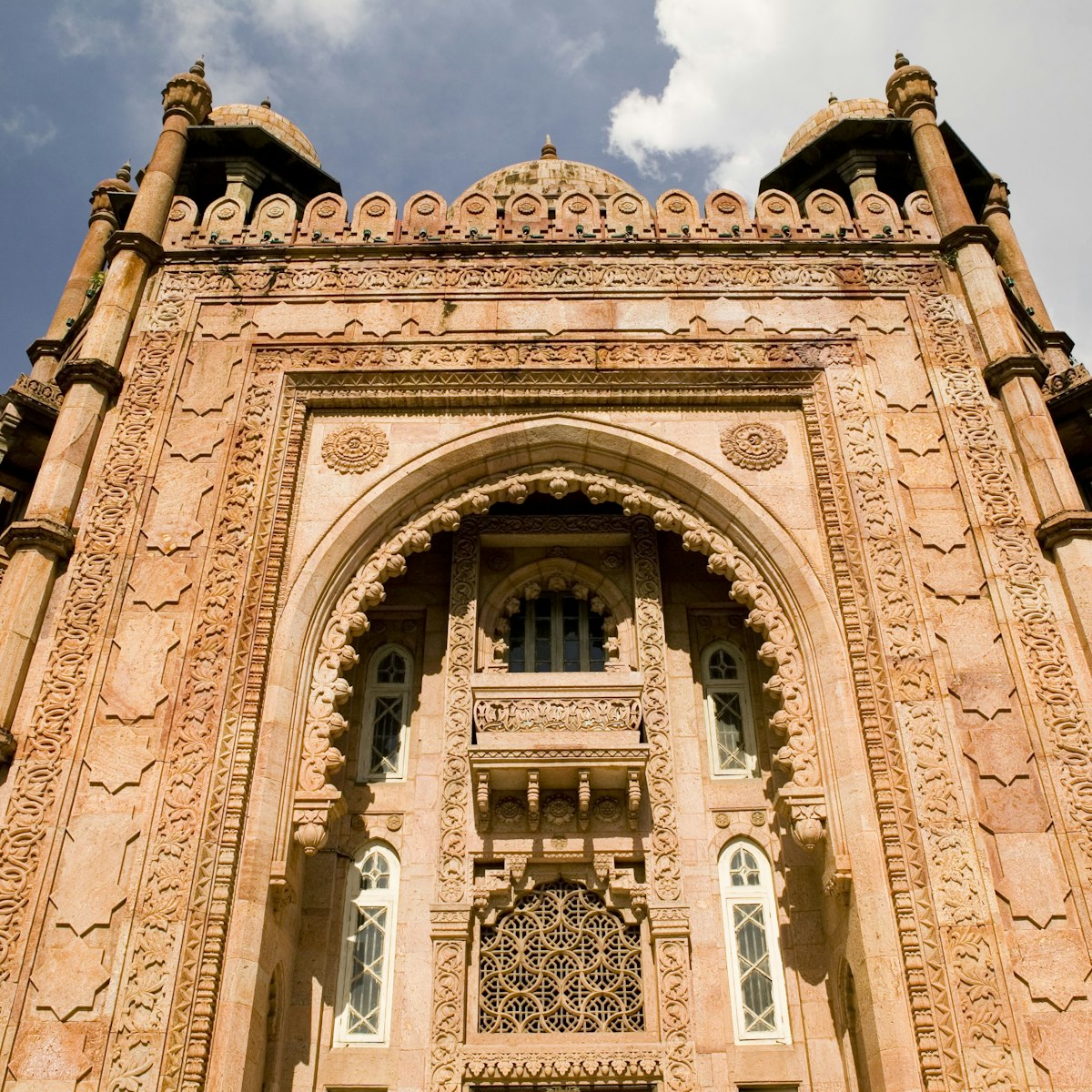
Government Museum
Housed across from the striking British-built Pantheon Complex, this excellent museum is Chennai’s best. The big highlight is building 3, the Bronze…

Kapaleeshwarar Temple
Mylapore is one of Chennai's most characterful and traditional neighbourhoods; it predated colonial Madras by several centuries. Its Kapaleeshwarar Temple…

Cholamandal Artists’ Village
There’s a tropical bohemian groove floating around Injambakkam village, site of the Cholamandal Artists’ Village, 10km south of Chennai's Adyar River…

Trimurti Cave Temple
29.03 MILES
At the northern end of the Mamallapuram Hill compound, the Trimurti Cave Temple depicts the Hindu 'trinity' amid guardian figures: Brahma (left), Shiva …
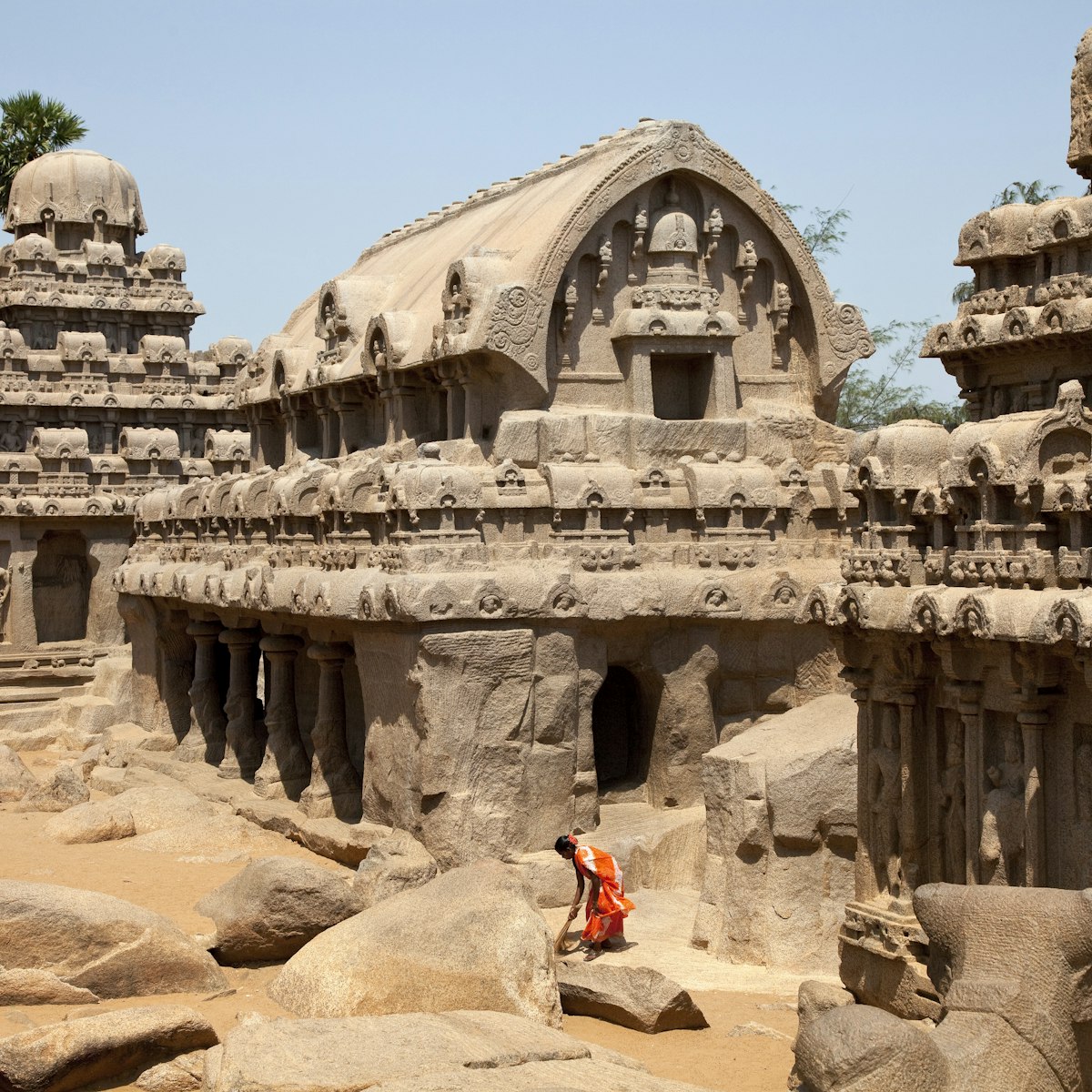
Five Rathas
29.78 MILES
Huddled together at the southern end of Mamallapuram, the Five Rathas were, astonishingly, all carved from single large rocks. Each of these fine 7th…
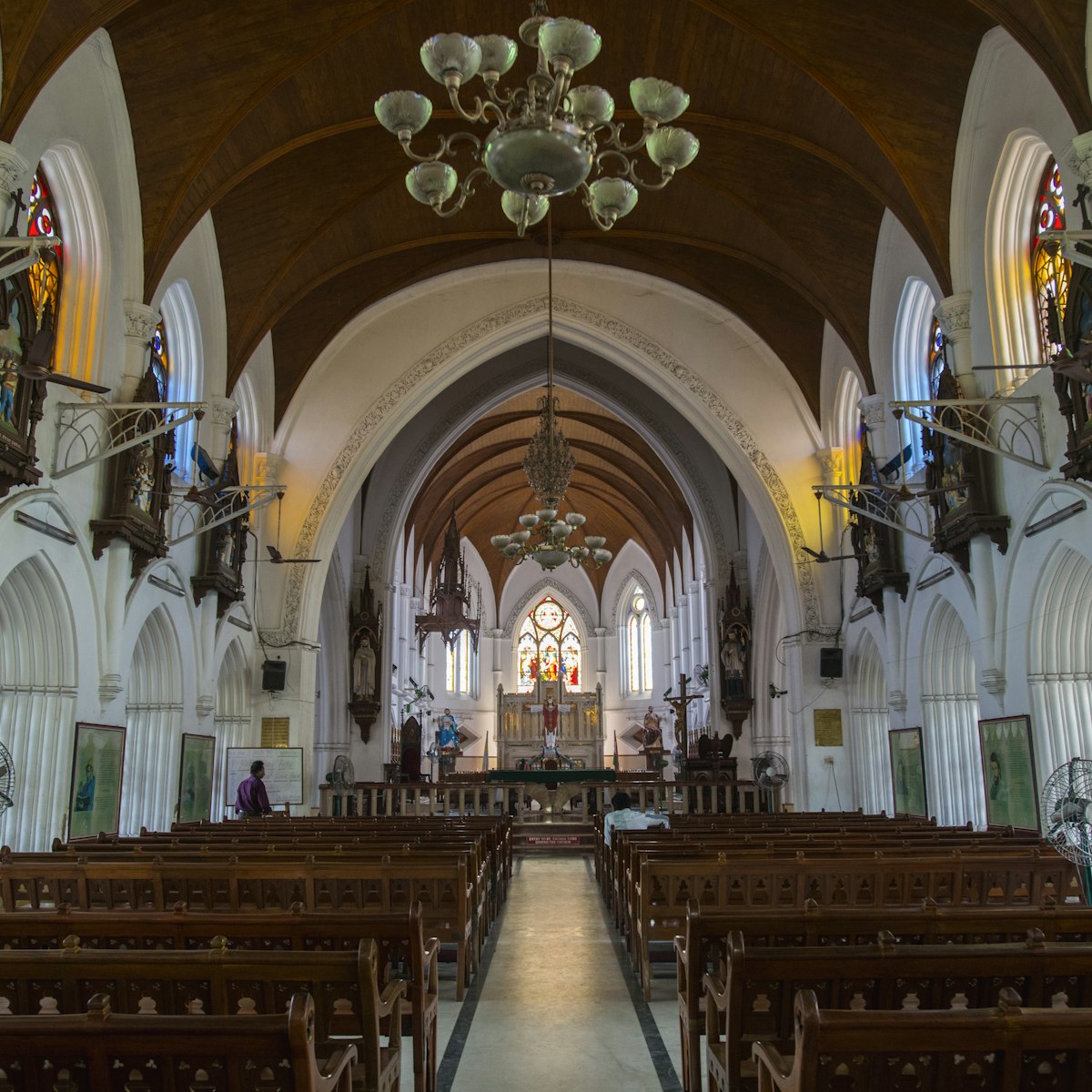
San Thome Cathedral
This soaring Roman Catholic cathedral, a stone's throw from the beach, was founded by the Portuguese in 1523, then rebuilt by the British in neo-Gothic…

Shore Temple
29.16 MILES
Standing like a magnificent fist of rock-cut elegance overlooking the sea, surrounded by gardens and ruined courts, the two-towered Shore Temple…
Nearby Chennai (Madras) attractions
1 . San Thome Cathedral
2 . Madras Lighthouse
At the southern end of Marina Beach, the fourth-incarnation Madras Lighthouse is India's only one with a lift; it's ridiculously popular, but the…
3 . Kapaleeshwarar Temple
4 . Sri Ramakrishna Math
The tranquil, flowery grounds of the Ramakrishna Math are a world away from Mylapore's chaos. Orange-robed monks glide around and there’s a reverential…
5 . Luz Church
Styled with blue-and-white baroque elegance, pretty little palm-fringed Luz Church is Chennai's oldest European building, dating to 1516 – which also…
6 . Vivekananda House
The marshmallow-pink Vivekananda House is interesting not only for its displays on the famous ‘wandering monk’, Swami Vivekananda, but also for its…
7 . Marina Beach
Take an early morning or evening stroll (you don’t want to roast here at any other time) along the 3km-long main stretch of Marina Beach and you’ll pass…
8 . Parthasarathy Temple
Built under the 8th-century Pallavas and unusually dedicated to Krishna (a form of Vishnu) as the charioteer Parthasarathy, this is one of Chennai's…

- WEB STORIES New
- ENTERTAINMENT
- CAREER & CAMPUS
- INFOGRAPHICS
- ISL 2023-24

- Manorama Online
- Manorama News TV
- ManoramaMAX
- Radio Mango
- Subscription

India rout England, sail into Thomas Cup quarterfinals
Chengdu (China): Defending champions India sailed into the knockout stage of the Thomas Cup with a 5-0 rout of England in a Group C contest here on Monday.
India, who defeated Thailand 4-1 in their opening tie, notched up a second consecutive win to qualify for the quarterfinals.
H S Prannoy returned to winning ways, defeating Harry Huang 21-15, 21-15 to give India a 1-0 lead.

India will be considered a badminton superpower from now on: Padukone

Camaraderie, commitment helped us win Thomas Cup: Prannoy
"To give a start to the team is really important, it gives a good boost to the team to go ahead. It is really important to finish off the matches clinically, you saw against Thailand one match was bad for us. So it's important to finish off the matches clinically," Prannoy said after the win.
The star pair of Satwiksairaj Rankireddy and Chirag Shetty was stretched to three games by Ben Lane and Sean Vendy in the first doubles fixtures before 2022 world champions bronze medallists scored a 21-17, 19-21. 21-15 win in one hour five minutes.
Former world No. 1 Kidambi Srikanth recorded a 21-16, 21-11 victory over Nadeem Dalvi to give India an unassailable 3-0 lead.
"Happy with the way both the matches have gone for me (in the tournament). There is a lot of pressure on players to win games. I feel I have played little easier opponents so far. But from now we will face better opponents and I have to be my best," Srikanth said.
On his recent form, Srikanth said "I'm playing well but not able to pull off the matches. Obviously people will compare how I was playing from 2021-2022. I was in my 20s then."
The second doubles pair of MR Arjun and Dhruv Kapila then brushed aside Rory Easton and Alex Green 21-17, 21-19.
In the final match, 24-year-old Kiran George prevailed 21-18, 21-12 over Cholan Kayan to wrap up the fixture.
India will take on group toppers and record 14-time champions Indonesia in their final group fixture on Wednesday.
- Other Sports

Hima Das to make comeback at Indian GP 1

Indian women enter Uber Cup quarterfinals

Indian teams off to winning start in Thomas and Uber Cup

Paris 2024 Olympic flame sets sail for France

Paris Olympics organisers receive flame in Athens ahead of torch relay

Chess sensation Gukesh returns home to rousing reception

Kerala state junior basketball: Ernakulam, Thiruvananathapuram champions

Bonmati, Djokovic win top honours at Laureus Awards

IMAGES
VIDEO
COMMENTS
There is more evidence of St. Thomas's life in India than anywhere else; in 1956 Pope Pius XII granted minor basilica status to San Thome Cathedral in Madras.
This is the earliest known record of his death. That is about all one can know for sure. Martyrdom of St. Thomas—Peter Paul Rubens (1636-1638) Thomas, the Doubting One, took the life and resurrection of Jesus of Nazareth almost 3,000 miles from Jerusalem to the people in India. He ministered for 29 years in that land.
I will be trying to present as briefly as possible the evidence that points to the conclusion that St. Thomas's visit to the shores of South India is not unfounded. St. Thomas in India. The Doctrine of the Apostles, which was probably written in the second century AD, mentions that St. Thomas evangelised India. We also have St. Ephraem (A.D ...
The 18th-century St. Thomas Cathedral at Pala, situated on the bank of the River Meenachil, about 40 miles southeast of Kochi, is a fine example of colonial church architecture, including a ...
This being so, the character and mission of Jesus, the Christ of India, can be traced in that of his apostle Thomas. Thomas is a nickname derived from the Syrian (Aramaic) word t'omo, which means twin. The apostle's true name was Judas, as is recorded in the ancient Syriac gospel texts, but it was not used in later gospel texts so he would ...
Tradition among the Christians of St Thomas of the Malabar Coast about the apostle Thomas claims that he came to them via Socorta. The first notice of the Christians of St Thomas in Socorta is given by Cosmos Indicopolisteus who wrote in 535 A.D. Francis Xavier a thousand years later spoke of the nominal presence of Christians in Socorta.
St. Thomas (born, probably Galilee—died 53 ce, Madras, India; Western feast day December 21, feast day in Roman and Syrian Catholic churches July 3, in the Greek church October 6) was one of the Twelve Apostles.His name in Aramaic (Teʾoma) and Greek (Didymos) means "twin"; John 11:16 identifies him as "Thomas, called the Twin." He is called Judas Thomas (i.e., Judas the Twin) by the ...
St Thomas was one of Jesus's 12 original followers. He is believed to have spread Jesus's word far and wide, coming to India in the process. However, due to lack of documentary evidence, St Thomas's visit to India is a subject of lively debate.
The Acts of Thomas. is an early third-century attestation of a missionary narrative in the Syriac tradition that attributes the conversion of India to Saint Thomas, the apostle known as Jesus's twin (John 20:24). 1. In this extended apocryphal narrative, Christ commissions Judas Thomas to travel to India to convert its people. 2. Thomas
Certainly the first Christian to visit India, Saint Thomas arrived here around 52 AD. We all know him by the nickname "Doubting Thomas" but upon putting his hands into the resurrected body of Jesus, he became an ardent follower and evangelizer. ... the spear or the lance head that was used to kill St. Thomas, his fingerprint, an Episcopal ...
The legend of St Thomas led to the first-ever recorded journey to India by an Englishman: according to the Anglo-Saxon Chronicle, King Alfred (he of the burned cakes) sent Bishop Sighelm of ...
The arrival of St. Thomas. The visit of St. Thomas is still a matter of dispute among historians. There are only very limited details about him in the Bible. He appears thrice in the Gospel of St. John (St. John 11:16, 14:5, 20: 25-29). The three occasions are the resurrection of Lazar, the Last Supper, and the resurrection of Christ.
Various historical records and traditions indicate that Thomas traveled by sea to India in AD 52. He was later martyred and buried there after witnessing to the Indian people. The tomb of St. Thomas is in Mylapore, India. A poet, St. Ephrem, recorded in his hymns and poetry that Thomas worked miracles in the Indian city of Edessa.
Nowadays, the church is a major pilgrimage center. It is believed that St. Thomas first landed in Kodungallur on a ship in the year 52 AD. According to Christian tradition, which is followed by the Syrian Christians of Kerala in India, these areas constitute the path of St. Thomas.
In 345 AD another Thomas arrived in Kodungallur. This was Thomas of Cana, leader of a well-organised group of Christian families, accompanied by clergy. They had fled as refugees from Persia, where thousands of their co-religionists were suffering martyrdom in a ferocious persecution. The newcomers quickly made contact with the local Christians ...
Thomas in Parthia. Thomas established Christian communities along the western and eastern shores of (modern-day) India, and many of those are still going strong. Thomas was martyred in Mylapore, Chennai, on the Bay of Bengal in the south of India. Many streets in that area today bear the name of Thomas. The author of Thomas the Apostle lived ...
APOSTOLIC PILGRIMAGE TO INDIA. ADDRESS OF JOHN PAUL II. ON OCCASION OF THE VISIT TO SAINT THOMAS MOUNT. Madras (India) Wednesday, 5 February 1986. Dear Archbishop Arulappa, Dear Brothers and Sisters of Madras, "Let us also go, that we may die with him" . With these words, Saint Thomas showed his desire to be with Jesus, even in the face of death.
Thomas the Apostle (Greek: Θωμᾶς; Syriac ܬܐܘܡܐ, Tʾōmā, meaning "the twin"), also known as Didymus (Greek: Δίδυμος Didymos, meaning "twin"), was one of the Twelve Apostles of Jesus according to the New Testament.Thomas is commonly known as "Doubting Thomas" because he initially doubted the resurrection of Jesus Christ when he was told of it (as is related in the Gospel of ...
The sarcophagas where Thomas' relic was interred is still within, and has not been opened for almost three hundred years. The Basilica of St. Thomas is located in the Mylapore district of Chennai, about six miles south of downtown and close to the Bay of Bengal. It is open every day from 6:00am-6:00pm.
Regarding St. Thomas tradition he said in 431 A.D.33 the following words, "So God, bestowing His holy gifts in all lands, sent His apostles to the great cities of the world. To Patrians, He sent Andrew, to John the charge of Ephesus he gave of Europe and Asia, their errors to repel with effulgence of light.
Aug 3, 2017 at 5:36. 3. There is no evidence. It is just a false historical narrative to somehow prove that Christianity is an ancient religion in India. Even 8th century Sri Adi Shankaracharya haven't mentioned anything in his works about any such thing while he was from Kerala where St. Thomas was supposed to have arrived in 52 CE. - Rolen Koh.
San Thome Church, officially known as St Thomas Cathedral Basilica and National Shrine of Saint Thomas, is a minor basilica of the Catholic Church in India, at the Santhome neighbourhood of Chennai, in Tamil Nadu.The present structure dates back to 1523 AD, when it was built by the Portuguese over the tomb of Thomas the Apostle. In 1896, it was renovated in the Madras province according to neo ...
India, Asia. Chennai (Madras) Behind San Thome Cathedral is the entrance to the weirdly chintzy tomb of St Thomas the Apostle. It's believed that, in AD 52, 'Doubting Thomas' introduced Christianity to the subcontinent, before being martyred at St Thomas Mount, Chennai, in AD 72. Most of his mortal remains are believed to now be in Italy, but a ...
Chengdu (China): Defending champions India sailed into the knockout stage of the Thomas Cup with a 5-0 rout of England in a Group C contest here on Monday. India, who defeated Thailand 4-1 in their opening tie, notched up a second consecutive win to qualify for the quarterfinals. H S Prannoy returned to winning ways, defeating Harry Huang 21-15 ...